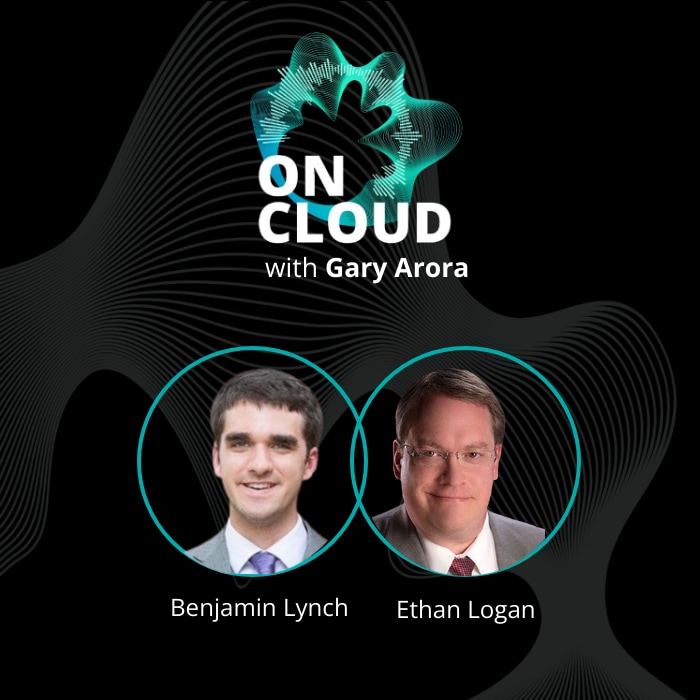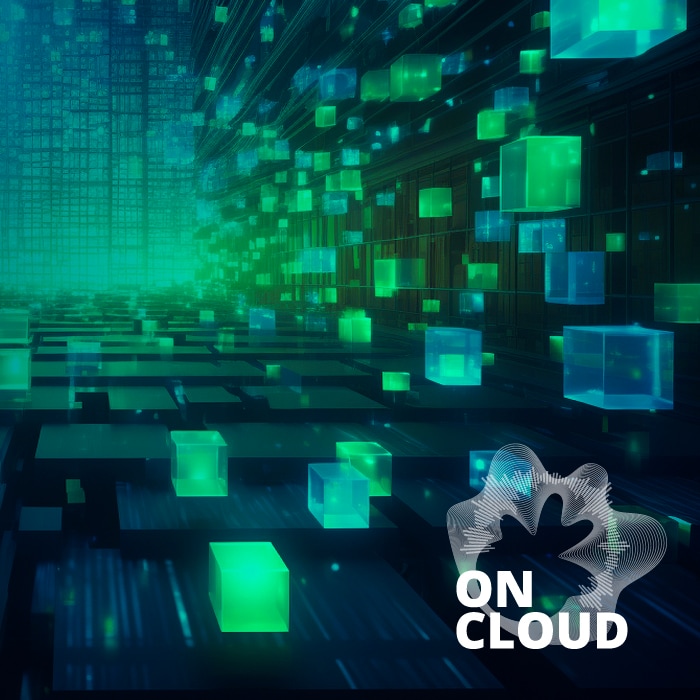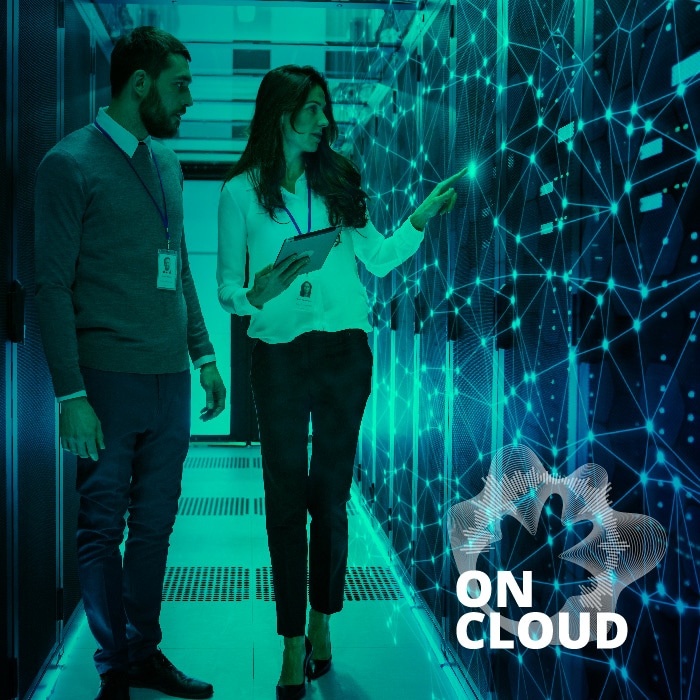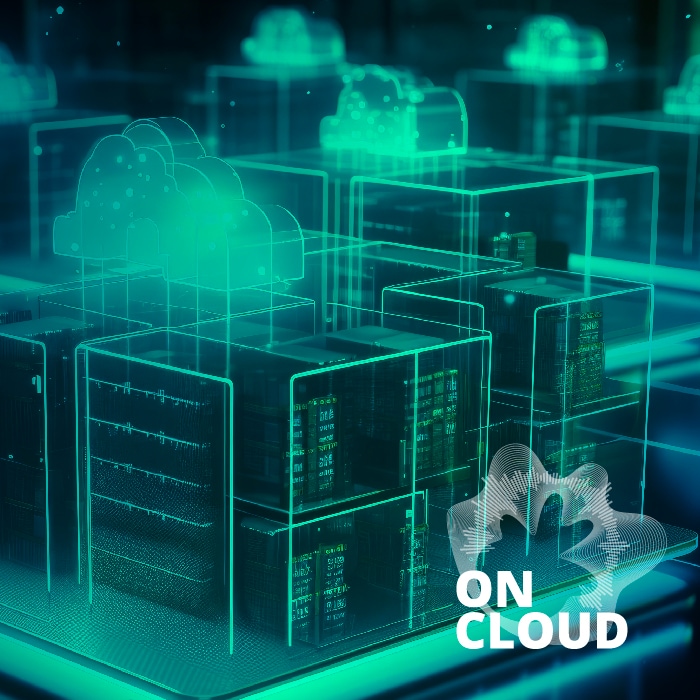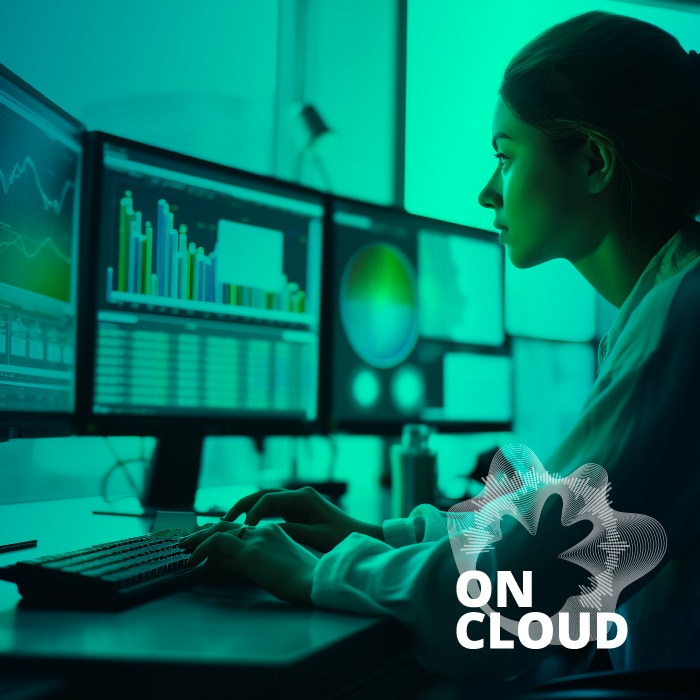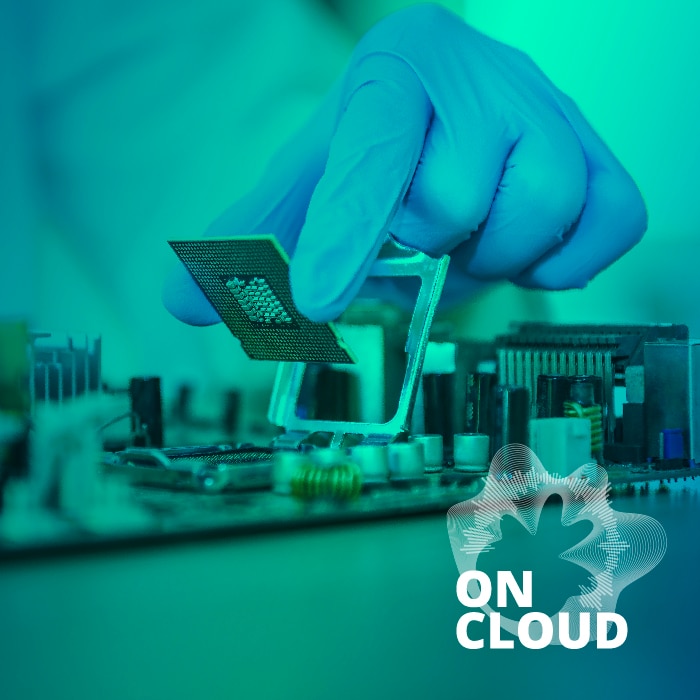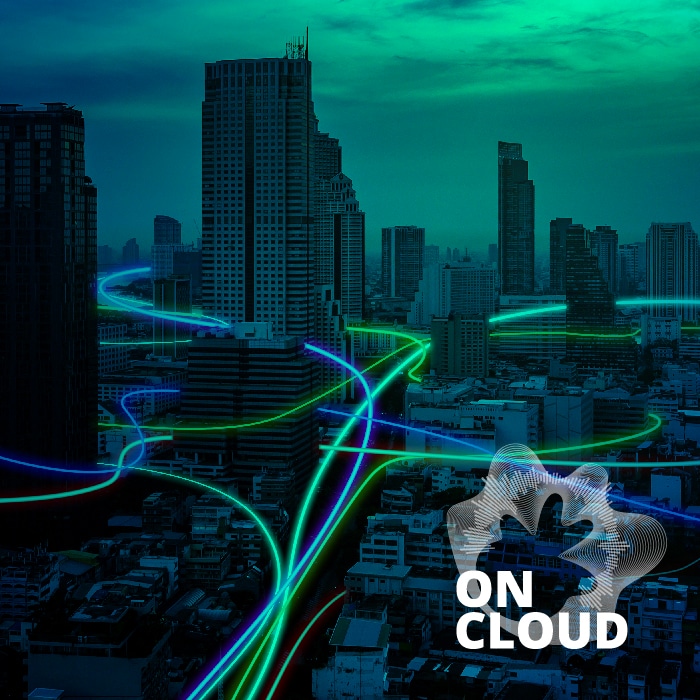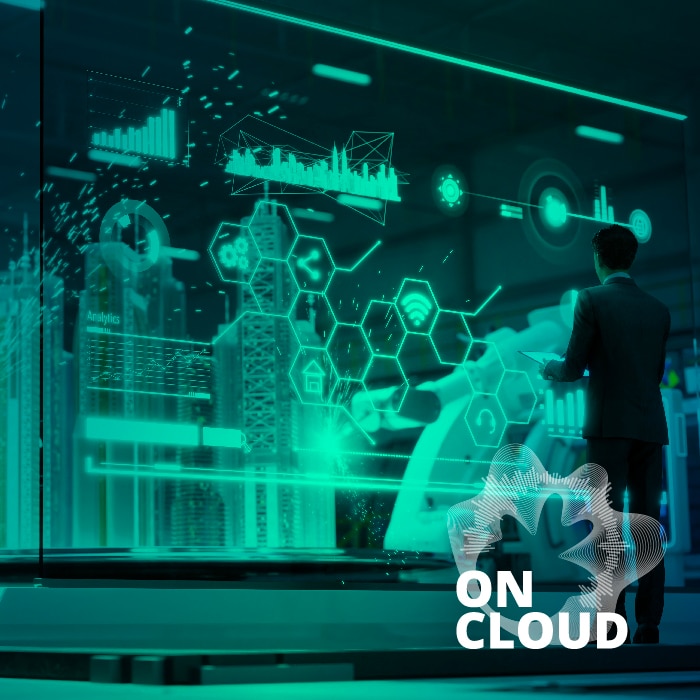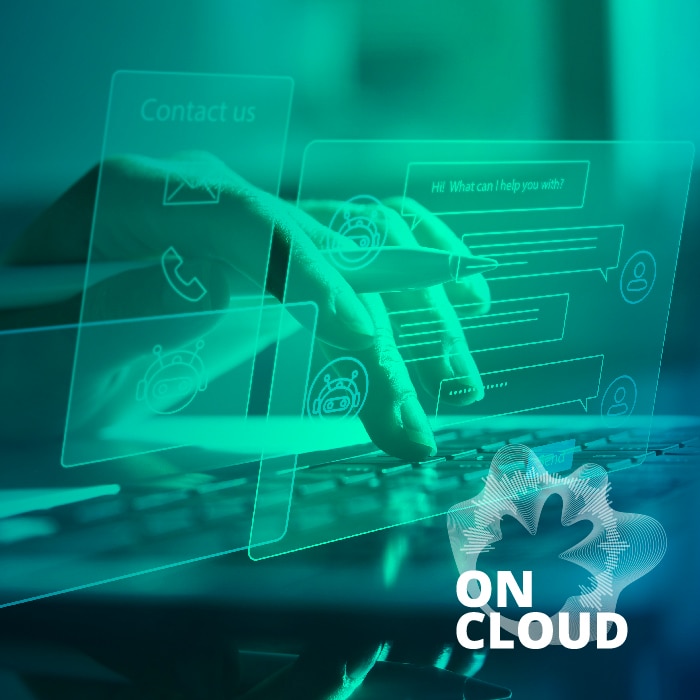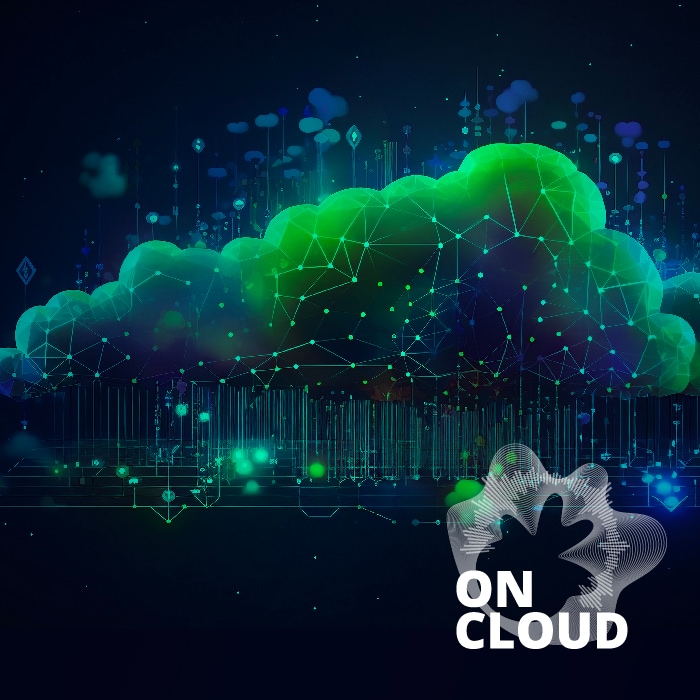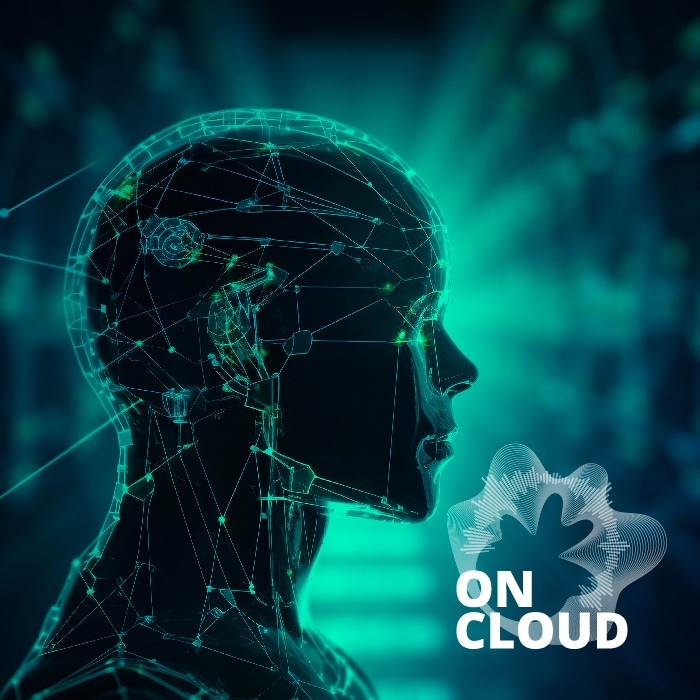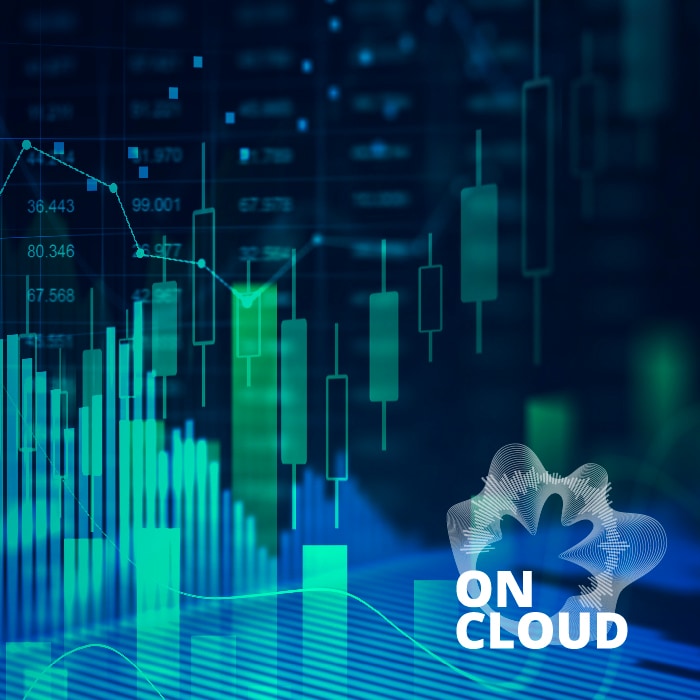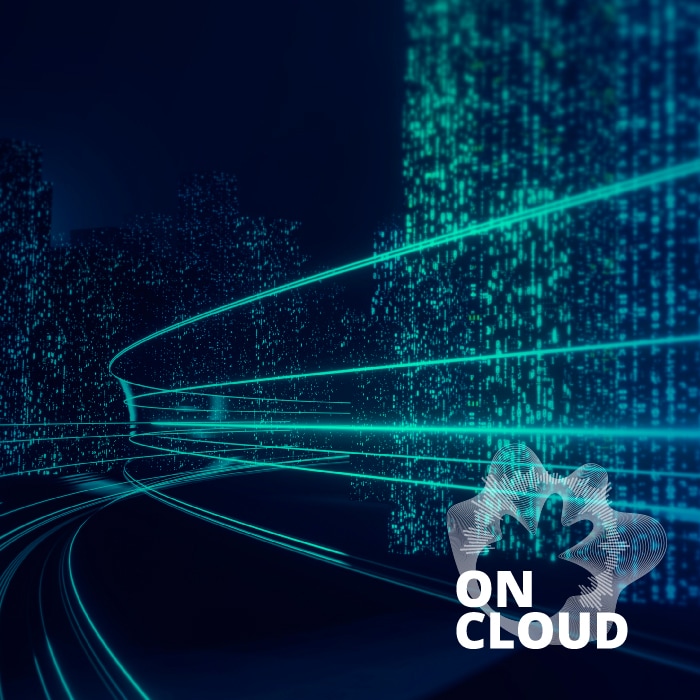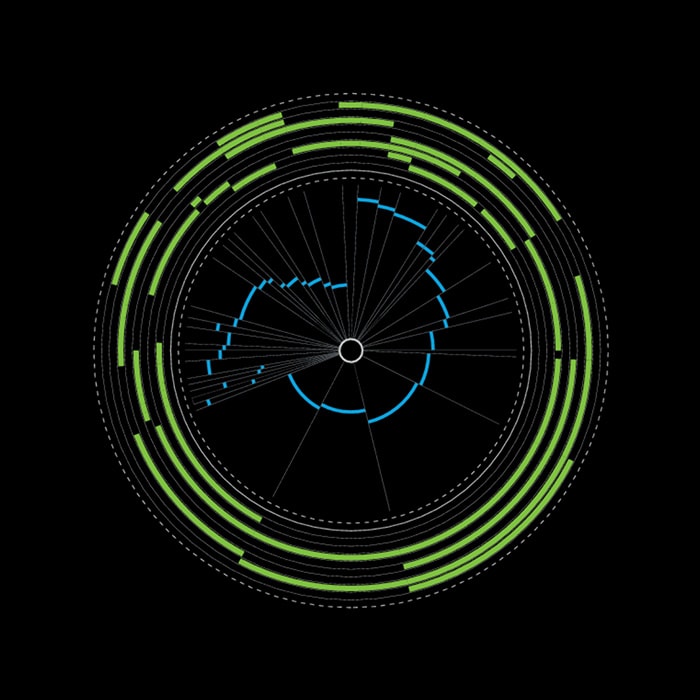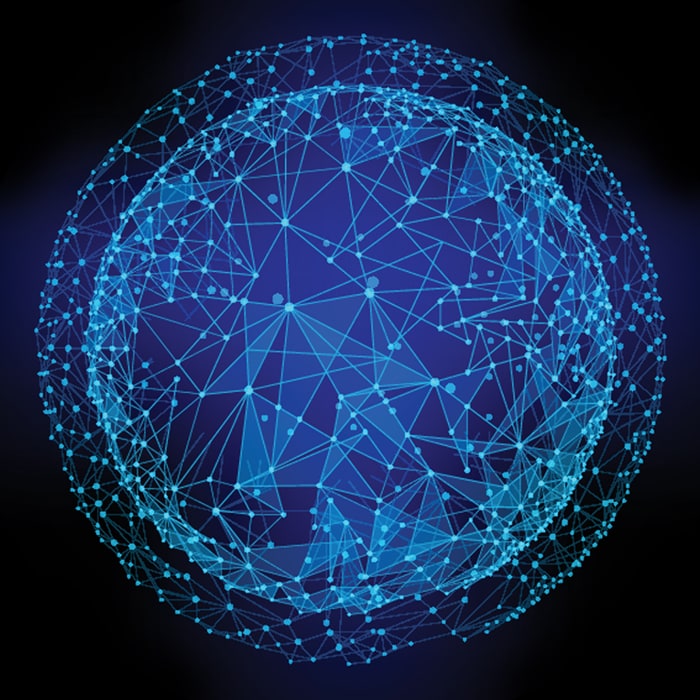Deloitte On Cloud podcast has been saved

Podcast
Deloitte On Cloud podcast
Rise above the noise with the On Cloud Podcast
Our On Cloud podcast tackles the tough topics that can help you navigate cloud your way and master the fundamental shift toward business and digital transformation enabled by cloud. We challenge leading industry innovators to deliver straight talk on what’s new and what’s next for cloud. These honest conversations, from those who’ve been there and navigated cloud with its successes and pitfalls, can help you drive faster, safer digital and business transformation—which can help spur innovation and impactful results. Tune in to discover how you can engineer your possible with the Deloitte On Cloud podcast.
Cloud, in context
Cloud is more than technology. It’s about making cloud work for your business to enable transformation. Our On Cloud podcast features leading industry innovators who provide their unique perspectives around the technology, business, and culture of cloud to help you achieve your cloud goals. Topics range from an enterprise, strategic look at cloud to practical discussions of how people, processes, and technology can help you make cloud work better for your organization.
Listen to the Deloitte On Cloud podcast to get the information you need to engineer what’s possible with cloud.
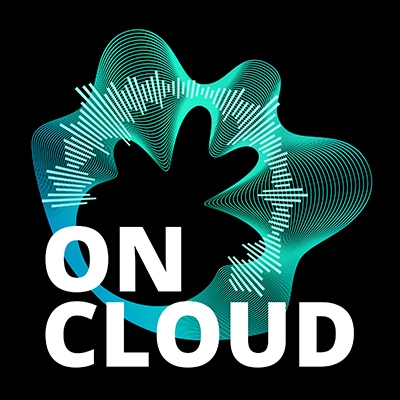
How higher education is using AI to innovate for growth
In this episode, Gary Arora, Ethan Logan, former VP of Enrollment and Student Experience at Western Kentucky University (WKU) and Deloitte’s Benjamin Lynch discuss how WKU used AI-driven predictive modeling to reverse declining enrollment, optimize recruiting, and boost net tuition revenue by $2.3 million. The lessons WKU learned in its journey go beyond higher education, however, to show how AI-powered analytics can spark innovation, enhance efficiency, and drive growth in any industry.
Unpacking the trends in the new DORA State of DevOps report
In this episode, Gary Arora is joined by Google Cloud’s Nathen Harvey and Deloitte’s Eddy Krumholz to explore the latest DORA State of DevOps report. They explore the evolution of DevOps, platform engineering, and AI’s role in the SDLC. They also discuss the “AI trust” gap in leveraging AI-generated code, the evolving challenges of AI and cloud adoption in a dynamic environment, and why culture remains a key differentiator of DevOps success.
How new technology is fueling the rise of smart vehicles
In this episode, Gary Arora sits down with Bob Monkman, senior principal at Red Hat, to explore how software-defined vehicles are transforming the auto industry. They discuss the challenges of modern vehicle software, the impact of DevOps, AI, and cloud, and how open source drives collaboration and innovation, enabling automakers to reshape their business strategies. They also touch on how the shift to continuous software development and subscription models is creating new revenue streams.
2025 tech trends: Agentic AI, governance, and sustainability
In this episode, Mike Kavis and Gary Arora discuss what they believe will be 2025’s top tech trends, including the rise of agentic AI, the benefits and complexity of sustainable technology, and the growing demand for upskilling talent. They also explore how organizations are tackling governance and standards policies around the growing integration of AI, while leveraging new AI advancements to drive innovation and growth in an increasingly competitive, global environment.
Cloud 2024: Trends and tech that will shape the future
In this episode, Mike Kavis spotlights key trends in cloud and software engineering for 2024. From intelligent edge computing and APIs to industry cloud platforms, hybrid cloud, and the role of AI in automation, this episode features highlights from the year’s most compelling conversations with IT leaders. The overarching theme of cloud for 2024 is that technology innovations are driving significant gains in operational efficiency, competitive advantage, and business value
These are the top five tech breakthroughs for 2024
In this Knowledge Short, Deloitte's Gary Arora reveals his candidates for the top five tech breakthroughs of 2024--exploring how chiplets are pushing the envelope on semiconductors, Generative AI is driving mainstream production, and quantum computing is accelerating innovation. Along with advances in solar, edge, and 5G tech, and the sophistication of large language models, these breakthroughs are setting the stage for an amazing future.
AWS re:Invent 2024: Analytics innovation and accelerated AI
AWS re:Invent 2024 is a wrap! In this episode, Gary Arora shares his top three highlights from this year’s incredible event. Innovations include Amazon S3 updates with managed Iceberg tables and real-time metadata; the cutting-edge Trainium2 AI chips; and AWS Nova, a multimodal foundational model for generating text, image, and video. From faster analytics to trailblazing AI performance, these innovative offerings are setting new standards for digital transformation technology.
Cybersecurity in the age of AI and quantum
In this episode, Gary Arora talks with Deloitte’s Julie Bernard and AWS’s PJ Hamlen about the future of cybersecurity, including the role of Generative AI and the coming impact of quantum computing. They cover leading practices for cloud security, AI’s potential to detect and defend against new threats, and why a culture of collective responsibility is essential. Julie and PJ also share their views on evolving risks and how leaders can prepare for a dynamic, unpredictable future.
Key insights from Sahithi Bayana and Ashwin Patil on the value of AI-driven app rationalization
In this episode, Deloitte's Sahithi Bayana and Ashwin Patil discuss how AI can enhance application rationalization in digital transformation. They break down how AI can help boost operational efficiency via automation, streamline data integration while minimizing business disruption, and enhance the customer experience with high-value-to-cost ratio initiatives. Sahithi cautions, however, that to achieve expected business value, performance metrics should be tied to ROI.
To increase developer productivity, think holistically
In this episode, Mike Kavis talks with DX founder Abi Noda about how to better measure developer productivity. Abi believes traditional output metrics don’t tell whole the story. Instead, he says conventional metrics should be paired with those that track organizational, environmental, and cultural factors—all of which are included in the emerging discipline of developer experience, or DevEx. The pair also discuss the use of Generative AI for development and how it factors into productivity.
A sound API roadmap is essential for transformation
In this episode, Mike Kavis talks with Salesforce's Param Kahlon and Deloitte’s Kurt Anderson about MuleSoft's “2024 Connectivity Benchmark Report.” The trio discuss how APIs, coupled with AI, enable digital transformation. Kurt and Param stress the importance of a sound API roadmap, and they believe that companies with effective API strategies view them as “products” and value producers that boost tech-investment ROI. Finally, they examine how AI-enabled automation can fuel innovation and growth.
How technology can boost sustainability and fuel innovation
In this episode, Deloitte Canada partner Jamie Sawchuk—a leader on sustainability and climate change—discusses why he thinks that mitigating climate change and pursuing corporate sustainability efforts don’t have to be at odds with business growth and innovation. Why? Jamie thinks it’s because next-gen tech solutions like Generative AI, coupled with community sustainability initiatives, can both mitigate the effects of climate change and drive the innovation that powers long-term growth.
Deloitte's Brian Campbell on the what, why, and how of industry clouds
In this Knowledge Short, Deloitte’s IndustryAdvantage™ Leader, Brian Campbell takes a deep dive into industry clouds. He gives a short definition of what they are, who they’re for, and how they work, and he takes a high-level look at the significant market and vendor trends. Next, Brian discusses how organizations can be successful in deploying industry clouds and the challenges and benefits they should expect. Finally, he looks forward to predict where the industry cloud movement is headed.
IBM's Roger Premo on reshaping the organization for cloud's third wave
In this episode, Mike Kavis talks with IBM’s Roger Premo about Roger's upcoming publication, “Are You Ready for the Cloud’s Third Wave?” They discuss the principle of hybrid by design and its philosophy of intentionality. According to Roger, designing for the next generation of cloud involves cultivating a product-development mentality for IT, removing organizational silos, redesigning the operating model, and planning for a future that includes the ubiquity of Generative AI.
DevOps leader John Willis on why and how to avoid AI anarchy
In part three of our series with DevOps leader John Willis, Mike Kavis and John extend their discussion on AI. John strongly believes that, in light of Generative AI’s growth, it’s unrealistic for organizations to continue to block its use because it will simply lead to shadow-AI anarchy. Instead, John says it’s essential to embrace AI, but in the right way—which includes setting realistic objectives for its use, developing AI governance policies, and training workers on how to follow them.
DevOps leader John Willis on how SRE helps reduce shadow AI
This episode—part two of a three-part series with DevOps leader John Willis—focuses on “shadow AI.” Similar to the more-familiar “shadow IT,” shadow AI is the unconstrained expansion of AI that creates operational chaos and adds to technical debt. It occurs when organizations fear embracing AI but workers use it anyway—though without governance. To fix shadow AI, John says, companies should embrace AI, constrain it with site reliability engineering, and leverage it to meet business goals.
John Willis on how Deming’s theories can elevate software engineering
In this first episode of a three-part series, Mike Kavis sits down with John Willis, DevOps expert and author of the book, “Deming's Journey to Profound Knowledge.” John recounts his DevOps journey and why he wrote about Dr. W. Edwards Deming’s management principles. He argues that Deming’s theories can be directly applied to software engineering to improve the development process and that two of Deming’s concepts—psychological safety and systems thinking—are absolutely critical.
Deloitte's Scott Buchholz gives a primer on quantum computing
In this episode, Deloitte Managing Director Scott Buchholz dives into quantum computing. He explains how it works and how it differs from traditional computing. He also touches on risks and provides sample use cases. However, he cautions that quantum computing capabilities are still experimental and not yet production ready. Nonetheless, he strongly advises that companies educate themselves on quantum computing’s power and collaborate with their hyperscalers to plan for a quantum future.
Unlocking potential: Deloitte's Mike Kavis explores the power of Generative AI
In this Knowledge Short, Mike Kavis offers a primer on Generative AI. He gives a concise definition of Generative AI and discusses possible use cases and their benefits. Next, he dives into how Generative AI does its job, discussing how AI models learn and create content, as well as the processing power they need to function. He also explores the impact of Generative AI on business performance. Finally, he touches on hot-button issues like data security and AI and human collaboration.
Unlocking innovation: Deloitte's Ryan Lockard on the Generative AI revolution in software development
In this episode, Deloitte’s Mike Kavis and Ryan Lockard talk about how Generative AI is revolutionizing the software development lifecycle. It’s all about speed, accuracy, and innovation. According to Ryan, Generative AI moves beyond yesterday’s code generators to include context, as well as codebase and pattern recognition. In short, Generative AI will help software applications—and the developers who build them—be more productive and innovative, which is a win for everyone.
Deloitte's Bill Briggs, Nicola Johnson, and Mamoun Hirzalla break down Google Cloud Next 2024
In this episode Deloitte’s Bill Briggs, Nicola Johnson, and Mamoun Hirzalla discuss Google Cloud Next 2024—what’s new and what’s next. Hint: It’s all about Generative AI. Highlights include increased capabilities for Google Gemini and Model Builder and a clear focus on reducing model hallucinations and improving results. Bill cautions, however, that data strategy and core modernization are keys to successful implementation. The team also discusses the future of cloud and Generative AI.
Qualcomm’s Atul Suri and Deloitte’s Rahul Bajpai on Generative AI and the edge
In this episode, Deloitte’s Mike Kavis talks with Qualcomm’s Atul Suri and Deloitte’s Rahul Bajpai about how AI is bringing innovation to edge computing. The trio discuss why companies are bringing AI capabilities to the edge, use cases for AI and edge, and how cloud enables this powerful combination. As to the why, it’s simple: AI can help companies increase productivity and develop new business models that create new revenue streams—which will drive sustainable growth and innovation.
The CTO Advisor's Keith Townsend on successfully implementing Generative AI
Generative AI couldn’t be hotter. Everyone wants in on the revolution. In this episode, The CTO Advisor’s Keith Townsend agrees that Generative AI is revolutionary, and he discusses cloud’s role in Generative AI, the decision-making process, and potential pitfalls around implementation. However, he also urges companies to base their Generative AI decisions on a trusted maxim: The value of a given project is proportional to the value it returns to the business.
Google’s Connie Fan and Deloitte’s Dr. Abdul Rahman on Generative AI and cybersecurity
In this episode, Connie Fan, product strategy and analytics lead at Google, and Deloitte’s Dr. Abdul Rahman examine the growing relationship between Generative AI and cybersecurity. They explain how Generative AI can boost cybersecurity through predictive modeling, and they discuss the need for enhanced security when training AI models—especially the LLMs used in Generative AI. Finally, they forecast the future of AI and cyber and discuss the importance of assessing AI and cyber risk.
Himanshu Varshney on how to build an excellent software engineering culture
In this Knowledge Short episode, Himanshu Varshney talks about how to build a strong software engineering culture. He lists the guiding principles his leadership team has developed and discusses keys to successful implementation. He also warns about crucial pitfalls to avoid. One universal theme throughout, however, is that a successful culture starts with leadership’s continued commitment to excellence and employee satisfaction.
Deloitte's global cyber leader, Emily Mossburg, discusses the latest in cybersecurity
In this episode, Emily Mossburg, leader of Deloitte’s Global Cyber practice, discusses growth areas, trends, and key priorities in cloud cybersecurity . Emily sees zero trust as the most explosive growth area in cyber, while the biggest trend is the need for organizations to adapt to Generative AI, remote work, and hybrid cloud environments. Finally, Emily argues that the integration of data sources and components is key to boosting security and maximizing value for the organization.
David Linthicum and Mike Kavis take a look at cloud for 2024
In this special LinkedIn Live edition of the podcast Deloitte’s David Linthicum and Mike Kavis forecast all the big trends and tech for cloud, 2024. They predict that 2024 is going to be the year that Generative AI begins to return value to the business, and that cloud optimization and multi-cloud management will become more critical than ever—partially because of Generative AI. They also engage in an animated discussion of how to balance workloads between on-premises and cloud.
Deloitte's David Linthicum and Mike Kavis look back at cloud in 2023
In this episode, Deloitte’s David Linthicum and Mike Kavis look back at cloud trends in 2023. Generative AI was the most momentous event in 2023, but there were other trends that played a significant role for organizations in cloud. Resilience, FinOps, talent management, and repatriation were top of mind for most organizations. As for the explosion of Generative AI, according to Mike, one thing is crystal clear: Cloud is absolutely the most critical component of a successful implementation.
IBM's Nick Otto on how hybrid clouds and Generative AI optimize value
In this episode, Nick Otto, head of global strategic partnerships at IBM, discusses how hybrid, open architectures, augmented with Generative AI, can help organizations optimize cloud value and get better insights that enable more effective decision-making. According to Nick, value isn’t optimized by mandates to move to cloud, or to transform in a certain way. Instead, optimization can be achieved by building a flexible, open, sustainable solution that can scale with the organization.
Carnegie Mellon’s Satya and Deloitte’s Rahul Bajpai talk edge computing
In this episode, David Linthicum talks with Carnegie Mellon’s Dr. Mahadev Satyanarayanan and Deloitte’s connected edge leader, Rahul Bajpai, about edge computing. The group discusses use cases for edge, connectivity, and edge clouds—or cloudlets. They also talk about which industries are leveraging edge computing successfully, and how these companies are returning value to the business with their edge deployments. Finally, Satya makes predictions about the future out on the edge.
Intel’s Josh Hilliker talks strategies to optimize your cloud architecture
In this episode, Intel’s Senior Director of Cloud Solutions, Josh Hilliker, talks with David Linthicum about strategies companies can use to optimize their cloud architectures to return more value from their investments. According to Josh, optimization is a matter of using optimization-as-code and finely tuning as much of the architecture as possible. To further optimize, it’s also important to govern effectively, with policy-as-code helping to automate the process.
VMware's Alexander Romero shares advice on how to succeed with Generative AI
In this episode, David Linthicum talks with Alexander Romero, VMware’s senior director for cross-cloud services, about the impact of Generative AI. They discuss issues that companies face when implementing Generative AI such as cost, complexity, information privacy, security, and intellectual property concerns. They also discuss VMware’s solution framework for these issues. Finally, Alexander shares his views on Generative AI’s future risks and benefits and how companies can navigate their Generative AI future.
Deloitte's Tony Witherspoon breaks down AWS re:Invent 2023
In this episode David Linthicum chats with Deloitte’s Tony Witherspoon about all the hot topics at AWS re:Invent 2023. They agree that Generative AI was the star of the show this year with AWS announcing Amazon Q, CloudWatch Application Signals, and AWS My Applications—all of which help organizations leverage Generative AI more effectively over diverse cloud architectures. Dave and Tony also discuss the future of Generative AI and concur that 2024 will be about taking Generative AI to the next level.
David Linthicum on how Gen AI changes cloud architecture
In this episode, David Linthicum discusses how Generative AI changes cloud architecture and what organizations can do to leverage Generative AI effectively. As David explains, the fundamental goal with Generative AI is to return as much value back to the business as possible with the implementation. This search for value requires re-evaluating the cloud architecture from top to bottom, from goals and objectives, to security, model selection, and scalability—and everything in between.
Cloud and AI can help airports enrich customers' experiences
In this episode, David Linthicum talks with AeroCloud Systems Ltd. CEO George Richardson about how his company helps airports leverage cloud and AI to make better decisions that lead to improved customer experiences. George’s take is that cloud and AI enable airports to connect disparate data sources, analyze data more effectively, and use it to transform their operations. The result? Enriched customer experiences that produce higher revenue and—potentially—increased market share.
Netskope's CISO on how midmarkets are leveraging emerging tech to innovate
In this episode, David Linthicum, Deloitte’s Chris Jackson, and Netskope Chief Security Officer Lamont Orange highlight the results of Deloitte’s 2023 Midmarket Technology Trends Report. The group talks about how midmarket companies are betting big on tech trends such as AI, cybersecurity, and innovation. They also discuss how companies are dealing with ongoing issues such as infrastructure modernization in an ever-changing tech environment.
An AWS specialist's view on how gen AI is transforming FSI
In this episode, David Linthicum talks with Ruben Falk - capital markets specialist, data platforms, machine learning, and generative AI at AWS - about how generative AI is transforming financial services. They discuss how gen AI will revolutionize processes across the enterprise, as well as how benefits gained will transfer to end customers. Falk cautions, however, that the regulatory environment for AI is growing, and ethical use of the technology is paramount.
Google's Forrest Brazeal on gen AI and the tech talent gap
In this episode, Forrest Brazeal, Google Cloud's head of developer media, talks with David Linthicum about why there’s an increasing talent shortage, how to address it, and how generative AI can be used as a tool to solve the problem. In Brazeal’s view, companies should use generative AI not to generate code that might not end up working, but to help new talent learn the process of software development on the job.
How banks are solving the cloud complexity conundrum
As both banks and regulators have accelerated their move to cloud, complexity has significantly increased. In this episode, David Linthicum talks with Red Hat’s Dr. Richard Harmon about how banks can rein in that complexity and leverage cloud to better meet regulatory requirements and manage risk. According to Richard, identifying critical failure points and adaptability play key roles, but the biggest determinant of success is an enterprise-wide cultural shift to a cloud-centric world.
A chief product officer's view on boosting cloud value
As cloud becomes the norm for many organizations, both challenges and opportunities abound. In this episode, David Linthicum talks with Russ Kennedy, Nasuni's chief product officer, about the challenges companies face migrating to cloud, controlling costs once they get there, and securing their cloud environment. Russ also discusses best practices that organizations can leverage to turn their cloud challenges into opportunities that return more value to the business.
Edge computing and its nearly endless possibilities
In this episode, David Linthicum talks with Darrell Jordan-Smith, senior VP of industries and edge at Red Hat, about how companies are learning to manage and grow their edge environments. They discuss new edge computing products and services and how companies are leveraging them to innovate and drive improved customer experiences. They also talk about current edge trends like containers, automation, open source, and data sovereignty, as well as the future of edge computing.
Optimize your cloud costs starting now
Who doesn’t want more value from their cloud investments? In this Knowledge Short, David Linthicum discuses how organizations can increase their cloud value by optimizing their cloud costs. It starts by assessing the cloud infrastructure with FinOps practices to understand spending patterns, then developing a cloud optimization strategy. To implement the strategy successfully, however, he cautions that it’s essential to build an organizational culture of optimization and accountability.
Companies are changing the way they use cloud to add value
Cloud brings tremendous innovation opportunities. In this episode, VMware’s William Lam talks with David Linthicum about the latest trends he’s is seeing in the cloud space—such as the rise in hybrid and multi-cloud, the modernization of on-prem architectures, disaster recovery, and the explosion of data and AI for insight-driven decision-making. The two also discuss how companies can leverage these trends at scale with sound planning and by optimizing cloud ecosystem connectivity.
Get the scoop here on Google Cloud Next 2023
Google Cloud Next 2023 was a home run! In this episode, David Linthicum talks with Deloitte's Kashif Rahamatullah about the news from this year's event. AI, and generative AI were the main focus of GCN 2023, with Google introducing more than a dozen AI infrastructure tools to help their customers take full advantage of generative AI. They also discuss how Google's partnership with NVIDIA will enable companies to better leverage large language models for generative AI.
Learn how LEOcloud is taking cloud and edge into space
Cloud in space? Yes, and it’s a booming market. In this episode, David Linthicum talks with LEOcloud Founder and CEO Dennis Gatens about how and why LEOcloud is taking cloud into space. The how includes taking custom-built software and edge computing into environments such as the International Space Station. The why is about advancing R&D capabilities, AI-based analytics, and AI-based autonomous operations. They also discuss the future of cloud in space and who the major players might be.
Cloud in space may be the next big business opportunity
The space race is on, again, and it’s creating tremendous business opportunities on Earth. In this episode, Deloitte’s David Linthicum, Kelly Raskovich, and Raquel Buscaino discuss how deploying cloud platforms in space can provide advantages to businesses that leverage them. Reduced launch costs have already sent more satellites to space, which has led to an explosion in data and insights, especially for companies that put cloud infrastructure in space to analyze it at the point of origin.
Generative AI is the future. Harness its power now.
Everyone seems to be jumping on the generative AI bandwagon, and with good reason. It promises to disrupt nearly everything we do and every interaction with technology. In this episode, David Linthicum talks with cloud architect and consultant Lynn Langit about generative AI and how it can potentially play a significant role in our daily lives—especially for businesses. They also discuss how to harness the full potential of AI, and they debate the future of AI and quantum computing.
Cybersecurity management must be customized to the enterprise
Cybersecurity is top of mind for most organizations today, but it’s a multi-faceted, challenging issue. In this episode, David Linthicum and Deloitte’s Justin Rowe talk about the importance of customizing cyber and data security to fit the vision, risk environment, and culture of the enterprise. They also discuss trends in cybersecurity—including the rapid emergence and benefits of artificial intelligence as a way to increase the effectiveness of cyber risk management.
Cloud success fuels an enhanced customer experience
What lies at the core of cloud success? For many companies, success is defined by how well cloud enables them to meet their customers' needs. In this episode, David talks with Manjula Talreja, senior vice president and chief customer officer at PagerDuty, about how cloud can help companies become more proactive and customer centric. According to Manjula, focusing on customer centricity helps deliver an enhanced customer experience that can lessen churn, increase revenue, and drive value.
Managing the disruption AI creates now—and in the future
There’s little doubt that AI, and especially generative AI, is upending markets. But how do we manage the change and disruption? In this episode, David Linthicum talks with Interarbor Solutions President and Owner Dana Gardner about some of the more challenging issues with AI. Dana's opinion is that the use of AI should be governed, moderated, and balanced in order to ensure that its power is harnessed as a positive force that adds value to our lives.
How banks drive innovation and business value with cloud
Cloud adoption continues to grow among banking institutions, but their reasons for implementing cloud are evolving. In this episode, David Linthicum talks with AWS’s Charith Mendis about how many banks now view cloud—and cloud-enabled technologies such as machine learning—as drivers of innovation, enhanced customer experiences, and increased business value. They are also making investments in initiatives that return the most value.
Cloud 2023: Looking back and predicting the future
Cloud is always changing, and in those changes lie great opportunities to return value to the business. In this episode, David Linthicum and Mike Kavis sit down to review those opportunities and debate cloud trends so far in 2023. They also try their hand at making predictions for the second half of the year and beyond. They touch on all the hot topics, from the impact of generative AI, cloud value and ROI to cost optimization via meta- and super clouds.
Lessons on creating a uniquely successful cloud career path
The great thing about cloud is that there are many career opportunities, and many paths to seize those opportunities. In this episode, David talks with Lucy Wang, owner of the YouTube channel, “Tech with Lucy,” about her non-traditional career path. The wide-ranging discussion covers Lucy’s background as a solutions architect, how she started and grew her channel, the skills and training solutions architects need to be successful, how the role is changing, and how cloud itself is evolving.
How CME Group is driving digital transformation success
Cloud transformations present many opportunities for growth and innovation, but they don't come without their challenges. In this episode, David Linthicum and Julie Winkler, the chief commercial officer at CME Group, discuss CME’s ongoing transformation journey. For Julie, the opportunities lie in fostering innovation and providing deeper customer insights to make better trading decisions. Overcoming challenges entails managing change and working with a solid collaborator for guidance.
Want a better cloud deployment? Here's how to get it.
Cloud can be a force multiplier and bring value to the business, but management challenges remain. In this episode, David Linthicum talks with Ron Batra, digital transformation and business value director at PagerDuty, about how to improve cloud management. They discuss using automation to separate the signal from the noise, reducing multi-cloud complexity, and leveraging industry clouds to enhance core competencies. Ron also offers his perspective on how innovation will power cloud’s future.
Three crucial issues that can help or hinder cloud ROI
Return on investment (ROI) is a core measurement of cloud success. In this episode, David Linthicum talks with Deloitte’s Diana Kearns-Manolatos, senior manager and digital research lead for the Center for Integrated Research about how technology dynamics can affect cloud ROI. According to Diana, three factors stand out: technological maturity, how well companies integrate technologies, and how individual technologies such as cloud, AI/ML, IoT, etc., can drive or detract from value.
Filling the tech skills gap with exceptional, veteran talent
As digital transformation initiatives accelerate, many companies continue to see talent shortages in key areas. In this episode, David Linthicum talks with SkillStorm's Chairman and Co-Founder Vince Virga about his successful solution to the problem. SkillStorm connects companies with veterans transitioning out of the military and provides them with the training they need to succeed in the rapidly changing tech environments of today and the future. It's a win-win situation.
How cloud-powered AI is transforming the US government
The US government (USG) is a hotbed of AI innovation right now, and that innovation is powered by cloud. In this episode, David Linthicum talks with Google Cloud’s Scott Frohman and Deloitte’s Vishal Kapur about how various USG agencies are using cloud as a force multiplier for their AI-fueled efforts to remake their agencies to better serve a modern nation. The trio discusses how the USG is leveraging AI and cloud, the benefits and challenges in the journey, and the future of cloud-powered AI.
A solution architect's view on cloud and its challenges
Cloud, and its ecosystem, can look different depending on your perspective. Those in the C-suite often have a different view than those on the front line. In this episode, David Linthicum talks with Google Cloud Solution Architect Sonakshi Pandey about her perspective on a solution architect’s role, what different business leaders desire from cloud, challenges enterprises face with cloud and analytics, and the future of cloud. They also discuss her leadership role in Women Who Code.
The next ten years for cloud: Big things are on the horizon
What’s the future of cloud? In this Knowledge Short, David Linthicum takes us ten years into the future. His predictions? Multi-cloud complexity increases, but so does the use of superclouds to rein it in. Skills change, specialize, and grow to meet demand. Artificial intelligence changes everything. Local, regional, and industry clouds will continue to rise. But, perhaps the most surprising prediction is that “cloud” won’t exist; it’ll just be computing because cloud will be so ubiquitous.
Digital transformation: Key elements for a successful journey
Digital transformation is absolutely necessary for most organizations, but it’s also probably the most challenging journey many of them will ever undertake. In this episode, David Linthicum talks with noted author Thomas Erl about some key elements and strategies that are critical to a successful journey. For Thomas, success results from good leadership that intuits the right pace for transformation, understanding the customer, making data-driven decisions, and continually communicating.
FinOps: It's about culture and business, not just technology
FinOps is a hot topic right now because it can help optimize growing cloud costs. However, many companies aren’t sure how to get started with FinOps or implement it effectively. In this podcast David Linthicum talks with the FinOps Foundation’s Executive Director J.R. Storment and Chief Technology Officer Mike Fuller, authors of the book, Cloud FinOps: Collaborative, Real-Time Cloud Value Decision Making, about the cultural and technological changes that accompany FinOps. They also give advice on how to get started and what they think are keys to long-term success.
Strategy and communication drive cloud success at Ginnie Mae
For Ginnie Mae, or the Government National Mortgage Association, moving to the cloud was a new experience that was technically and culturally challenging, but ultimately successful. In this episode, David Linthicum talks with Dan Boling, Ginnie Mae’s chief technology architect, about their journey to cloud. From Dan’s point of view, success involved strong communication, driven by a sound cloud strategy with continuous testing and pilot projects. Culture change, governance, and strategic advanced planning also played a big role.
Leveraging data clouds to boost cloud performance and value
Though cloud adoption is rising, some enterprises aren’t seeing their desired cloud value and performance - but the problems aren’t insurmountable. In this episode, David Linthicum talks with Snowflake’s Jeff Hollan about how companies can improve their cloud operations and gain more ROI from cloud by leveraging their data effectively and utilizing a data cloud. Improved data strategy and governance, low data latency, collaboration, and giving developers the support they need are also imperative.
Geisinger Health's amazing journey to cloud success
Geisinger Health started their cloud journey with two goals: increasing agility and optimizing costs. They’ve succeeded—90% of their apps are in cloud. In this episode, David Linthicum talks with Geisinger's Interim CTO Dan Bennett about their success and future plans. For Dan, their success is due to investing in their people to build cloud skills and in becoming a cloud-first, cloud-native organization. Their future lies in cloud-based analytics and infrastructure-as-a-service.
FinOps: A new path to cloud-cost optimization
As cloud adoption has soared, cloud costs have risen steadily, which has become a major concern for the C-suite. In this episode, David Linthicum talks with Deloitte’s Nikhil Roychowdhury about how FinOps can help control and bring transparency to cloud costs. For Nikhil, FinOps is a collaborative, cross-functional effort that involves breaking the cost-management process into manageable chunks, choosing the right tools for the problem, and building trust and alignment among stakeholders.
Optimization: Alternative solutions to cloud repatriation
Rising cloud costs are driving many companies to consider repatriating cloud apps back to on-premise environments. In this episode, David Linthicum and The CTO Advisor founder Keith Townsend discuss why repatriation might not always be the best option. Keith believes that the better choice is to optimize in cloud. To start the process, define what optimization means to you and pick strategies that fit your situation and budget, then get the right team and take things cloud native when you can.
Superclouds: The new way to rein in multi-cloud complexity
As multi-cloud has become the de facto architecture for many companies, complexity has emerged as one of the biggest hurdles to cloud value. Enter the supercloud, which is an architectural pattern that creates an abstraction automation layer, logically, on top of the multi-cloud environment. Superclouds provide a single control panel that spans an organization’s cloud ecosystem. They can’t hide poor architecture, but they can help manage multi-cloud complexity and provide more cloud value.
Blockchain will be the next great workplace disruptor
Companies use blockchain for logistics, IT security, data protection, and more. And its use cases are growing. In this episode, David Linthicum talks with Gigster’s Cory Hymel about how blockchain’s next frontier will be to disrupt the workplace by making it more fluid, which will change the relationship between companies and their employees.
Manage complexity and costs to increase your cloud value
As cloud matures, companies are focusing on getting more value from their cloud investments. In this episode, David Linthicum talks with Constellation Research’s Dion Hinchcliffe about current cloud issues and how organizations can increase their cloud value. According to Dion, success lies in embracing multi-cloud, reining in cloud costs, and using cross-cloud management strategies like superclouds to manage multi-cloud complexity. Commercial clouds will play a big role as well.
Get what's next for cloud with industry cloud solutions
Industry clouds are composable building blocks made up of cloud and other next-gen technologies that help companies more effectively solve sector-specific challenges. In this episode, David Linthicum talks with Salesforce’s Jujhar Singh about the rise of industry clouds, how they can help companies gain a competitive edge, and their evolving capabilities. They also discuss the future of industry clouds and their potential to help companies gain higher ROI from their cloud investments.
How Elevance Health has forged a successful cloud journey
The journey to cloud can be fraught with pitfalls, but there are many true success stories out there. In this episode, David Linthicum talks with Elevance Health's CTO Amish Patel about his organization’s cloud journey—and its ongoing success, despite many challenges along the way. For Amish, success is tied to reducing multi-cloud complexity with standardization, automation, orchestration, and a unified view of capabilities—and by creating a supportive, developer-friendly cloud culture.
Key strategies to address and remediate cloud-spend issues
According to some sources, cloud expansion and spend might soon slow significantly. While opinions on the subject might differ there have been some serious bumps in the road recently for cloud. In this episode, David Linthicum discusses cloud issues that are worrying the C-suite: cloud complexity and ballooning costs. He also gives advice on how to tackle them. First, figure out how cloud works best for your organization, then focus on planning and deployment, and, finally, adjust expectations to meet reality.
Cloud and AI will merge, but complexity will be a challenge
Cloud—despite some recent challenges—is the future of IT. That future is also increasingly intertwined with artificial intelligence (AI). In this episode, David Linthicum sits down with eWeek’s James Maguire to discuss the future of cloud and AI. According to James, cloud and AI will grow to be symbiotic and eventually merge, but that will only add to the complexity management challenge. In the future, superclouds will help mitigate complexity, and AI will be their engine for success.
Want a better cloud? Improve your cloud governance
Cloud has strong potential to improve business outcomes and foster innovation. However, to realize that potential, organizations must build an effective governance structure around their cloud ecosystem. In this episode, David Linthicum talks with Meredith Stein, co-author of Cloud Governance Basics and Practice, about how enterprises can establish effective governance for cloud, the benefits of good governance, and how cloud governance can affect sustainability efforts.
What's new, what's trendy, and what's next for cloud in 2023
The coming year looks bright for cloud, but only if companies can take better control of their cloud ecosystems. In this podcast, David Linthicum talks with Deloitte’s chief futurist, Mike Bechtel, about trends on the horizon that can help organizations brighten their cloud future. Mike’s perspective is that taming cloud complexity via abstraction, leveraging observability, and taking control of data can result in better cloud operational efficiency and better returns on cloud investments.
A cloud year in review: plenty of positives in 2022, but some growing pains too
The past year has been a mixed bag for cloud. Certainly, there have been positives like the rise of supercloud and metacloud to help reduce complexity, the growth of observability to provide deeper operational insights, and an increase in cloud-native development. However, cloud has also been beset by rising costs, complexity, and other challenges. David Linthicum provides his insight and analysis on all these topics—and more—in his review of 2022.
AWS re:Invent 2022—what's next for the future of cloud
AWS re:Invent 2022 was better than ever, and there’s lots of buzz around cloud's future. In this episode, David Linthicum sits down with Deloitte’s AWS alliance technical lead, Tony Witherspoon, to discuss all that was new at AWS re:Invent 2022. This year's key themes were sustainability, diversity and inclusion, efficiency, and data as a corporate asset. David and Tony also discuss two big product announcements—AWS DataZone and AWS Supply Chain—that they think will really impact cloud in 2023.
Corral cloud complexity to drive agility and innovation
Small, cloud-native companies can profoundly disrupt their larger, less-flexible competitors via agility and innovation, but cloud complexity still looms for both large and small enterprises. In this episode, David Linthicum talks with cloud influencer Ian Moyse about how any company—no matter its size—can leverage cloud to move quickly and innovate faster. However, it’s essential to reduce cloud complexity and sprawl to achieve a lean cloud ecosystem that drives innovation.
Want higher cloud ROI? Build a holistic cloud architecture
Many of the problems organizations have with realizing cloud ROI and value stem from an architecture that isn’t optimized for the overall business strategy, but instead for particular solutions or narrow business goals. In this episode, David Linthicum talks with Red Hat’s E.G. Nadhan about how companies can take a collaborative approach to ensure that their architecture is built and optimized to reflect the strategy of the business as a whole, not just a sum of its parts.
The modern cloud is here, and it's fueling the future
Cloud is undergoing a philosophical and technical renaissance. Innovation and disruption have become driving goals for cloud implementation, sustainability isn’t just a buzzword anymore, and the idea of super or metaclouds—fueled by open source—is gaining force across the cloud universe. In this episode, David Linthicum talks with IBM’s Roger Premo about this paradigm shift in cloud and how it’s driving companies to change the way they think about cloud now and in the future.
Cloud and AI together: Reshaping the future of business
AI has been around for more than three decades, but for most of that time, it’s been cost-prohibitive for many companies. In this episode, David Linthicum talks with Tom Davenport about his new book with Deloitte’s Nitin Mittal, All in on AI. The wide-ranging discussion covers how cloud enables cheaper, faster AI; how AI can help companies automate more of their business so their people can focus more on value-added activities; and the role and value of the modern Chief Data Officer.
Leveraging a product mindset to build apps with higher ROI
Though the concept of a “product mindset” isn’t new, over the past decade—with the ascendance of cloud—it has really started to gain traction as a better way to build cloud apps, or any app or system. In this podcast, David Linthicum talks with Twilio’s Anthony Lazaro about what a product mindset is, how companies can leverage it to build apps that generate high ROI for the organization, and how to develop a product mindset and culture to build apps at the pace of cloud.
Leveraging Observability to automate your cloud ecosystem
Observability is a huge help to organizations in solving systems performance issues, but some still see it as a bolt-on. In this episode, David Linthicum talks with Dynatrace’s Michael Allen and Deloitte’s Jay McDonald about why that isn’t so. The trio also discusses why companies should view Observability as a holistic process that can be built as code into every facet of their cloud ecosystem—from infrastructure, to apps, to security, to governance, to compliance, and more.
Hitting the cloud complexity wall—and hopping over it
Most organizations that have moved to a multi-cloud architecture have experienced cloud complexity. In this podcast, David Linthicum tackles the complexity issue and gives advice to mediate it. According to David, abstraction and automation are essential. First, deploy an abstraction layer above and across cloud platforms for tasks like operations, security, governance, and configuration management. Then, automate as many of those processes—especially operations—as you can.
Reducing complexity throughout your multi-cloud journey
Multi-cloud is here to stay, but for all its benefits there are hefty challenges too, such as complexity, heterogeneity, and inconsistent operations. In this podcast, David Linthicum talks with VMware’s Richard Munro about the many challenges of multi-cloud and how to solve them now, and in the future. Richard’s take is that right now, companies need use cross-cloud services for more consistency. The future will be about edge computing, better data management, and decentralization.
Shifting security left for enhanced multi-cloud security
Multi-cloud security is one of the most difficult pieces of the cloud complexity puzzle to solve for. It’s also one of the most critical. In this podcast, David Linthicum talks with Deloitte’s Ramesh Menon about how shifting security left—i.e., implementing appropriate security during application development to solve issues before systems go live—can help companies move from a reactive to a more proactive security posture and increase the effectiveness of their security program.
Need cloud talent? Here's how to find it—and keep it.
Despite a cooling job market in some sectors, many companies are still experiencing a shortage of cloud talent. In this podcast, David Linthicum talks with Deloitte’s Josh Haims about how companies can fill that gap. Josh’s take is that education must catch up with technology, companies should build a culture that attracts employees and builds tech fluency throughout the organization, and HR and the business need to build a closer relationship with a shared set of goals and outcomes.
Innovation, culture, and confidence drive higher cloud value
Why do some companies glean more value from their cloud investments than others? According to the recent Deloitte US Cloud Survey, cloud leaders spend purposefully to innovate, and they use technology as a force multiplier. In this episode, David Linthicum talks with Deloitte’s Chris Thomas and Diana Kearns-Manolatos about that survey, and about what sets cloud leaders apart. Bottom line: Leaders innovate, they build a strong software engineering culture, and they have confidence in cloud.
Successful digital transformation begins in the C-suite
Why do some digital transformation initiatives flounder while others succeed? One answer might lie with the C-suite leadership. In this podcast, David Linthicum talks with StarCIO's founder Isaac Sacolick about his latest book, Digital Trailblazer: Essential Lessons to Jumpstart Transformation and Accelerate Your Technology Leadership. According to Isaac, good leadership is about understanding how technology can serve the business, adapting to innovation, and building high-performance teams.
Blockchain is evolving, and it's taking on the world
Blockchain is evolving, and use cases for it may be almost limitless if the technology is harnessed effectively. In this episode, David Linthicum talks with Edgevana’s Mark Thiele about how blockchain has evolved and how it can help solve pressing problems ranging from protecting intellectual property and personal data, to boosting IT security, to detangling global supply chains, to democratizing computing in general. Mark also believes blockchain may someday underpin the emerging metaverse.
Observability: Taking monitoring to the next level
As cloud adoption increases and multi and hybrid clouds become the norm, operations become more complex and monitoring performance becomes more difficult. In this Knowledge Short podcast, David Linthicum talks about how the concept and practice of Observability goes beyond traditional systems monitoring to help IT teams observe, gain insight into, and maybe even predict what’s happening in their cloud ecosystem to better manage increasing complexity.
Smart factories: Using AI to build a better future
Manufacturers continue to respond to an increasing demand for products amid a volatile supply chain, labor shortages, and a fluctuating global economy. Improving production processes in the factory can help, but it’s not the only answer. In this podcast, David Linthicum and Deloitte’s Stephen Laaper talk about how companies can use AI and other cognitive tools to harness the vast streams of data collected from manufacturing operations to automate and increase safety, productivity, and quality and build the smart factory of the future.
Navigate to the next step with wearable cognitive assistance devices
Every so often, a technology comes along that has the power to change how we view and perform in the world. One of those just might be wearable cognitive assistance (WCA) devices. In this episode, David talks with Carnegie Mellon University professor Mahadev Satyanarayanan and Deloitte’s Arpan Tiwari about how WCA, via leveraging the edge and AI to augment human capabilities, will transform the way we work and live and open up worlds of knowledge and ability to anyone who wears a device.
Strategies for solving cloud's most pressing issues in 2022
As cloud moves into its second decade, there are still growing pains. In this episode, David Linthicum and Mike Kavis discuss cloud’s most pressing issues and offer solutions. Leveraging cloud for innovation, multi-cloud complexity, a talent shortage, and slowing cloud migration are the top challenges. The solutions? Focusing on value delivery, aligning business needs with technology, changing organizational culture, and realizing that slowing down isn’t necessarily such a bad thing.
Access disparate data with an extended enterprise multi-cloud
For companies that operate across geographies, IT architectures and regulatory requirements can make it difficult to access widely distributed data for analysis. Extended enterprise clouds (EEC) can help provide access to disparate data via augmenting the enterprise multi-cloud with third-party services such as vertical clouds, AI clouds, or data clouds—all with a common control plane. Building an EEC takes planning and a cultural change around data ownership, but it’s well worth the effort.
The vital role cloud can play in promoting sustainability
There’s little doubt that sustainability has become a global imperative. In this Knowledge Short, David Linthicum discusses the vital role cloud computing can play in sustainability initiatives. He makes the case that cloud computing is more sustainable because resource use is optimized, and cloud providers typically employ green operations practices. He also talks about other ways organizations can practice sustainability in their everyday operations.
DEI: The path to a stronger, more diverse cloud community
Diversity, equity, and inclusion aren’t just words; they’re a key component of success for nearly any endeavor, cloud computing included. In this podcast, David Linthicum talks with Deloitte's Josh Walker, co-founder of Black Orlando Tech, about his efforts to bring diversity to the tech workforce. They also discuss ways companies can change their culture to hire more minorities by creating a culturally diverse, friendly workspace and ensuring that minorities feel more welcome.
How to control cloud costs more effectively with FinOps
As cloud matures, managing cloud costs has become a top priority for many organizations. That’s where the new discipline of FinOps, or financial operations, can help. The goal of FinOps is to help companies manage and maintain accountability for cloud usage and costs. In this Knowledge Short podcast, David Linthicum explains what FinOps is, how it can help companies control cloud costs better, and how culture change and automation play a key role in FinOps implementation.
How cloud-native design enhances performance at the edge
Cloud-native design principles make cloud apps scalable, flexible, and more quickly deployable. Those principles can be applied to situations other than cloud, as well. Take edge computing, for instance. Edge can be thought of as a point-of-presence cloud, so applying cloud-native principles to the edge can make app performance, processing, and scalability cloud-like. And it can help solve the “edge war” of the future: the battle to reduce latency to its vanishing point.
Closing the gender gap and bringing more women to cloud
Look around at any cloud conference, and you’ll see a lopsided ratio of men to women. Why aren’t there more women in tech, and in cloud computing specifically? In this episode, David Linthicum talks with Deloitte’s Lisa Noon and Appgate’s Tamara Prazak about how to get more women into cloud. In the end, it comes down to bridging the STEM gap for girls early on, recruiting more women, and making their working lives more flexible. Cultural change also plays a big role in closing the gap.
Cracking the cloud-cost puzzle to gain more cloud value
Despite cloud’s many benefits, organizations are often shocked at its operational costs. In this episode, David Linthicum talks with Erik Peterson, co-founder and CTO of CloudZero, about how companies can leverage software engineering and focus on costs to optimize cloud spend and drive value. According to Erik, success lies in cooperation between finance and engineering to better understand the financial impact of cloud and close the feedback loop in terms of mapping costs to features.
AI at the Edge is very promising, but challenges abound
Edge computing isn’t a new concept, but pairing it with artificial intelligence holds new promise. However, there are significant challenges that companies must meet to realize the promise of Edge AI. In this episode, David Linthicum talks with ClearBlade’s Aaron Allsbrook about how Edge computing, paired with AI, works, and how it can give companies that leverage it a competitive advantage. He also lays out some challenges they’ll face to reach their Edge goals.
Chart your path to a fulfilling career in cloud computing
Cloud computing is a hot sector in IT right now, and many companies can’t hire enough workers to fill cloud roles. In this Knowledge Short, David Linthicum gives advice to anyone seeking to move into cloud computing as a career. David’s take is that no matter where you’re starting from—a college student or recent graduate, a non-IT worker looking to change careers or an IT professional looking to shift gears—you can find your path to cloud and a successful, often lucrative, career.
AI and cloud are powering the search for better information
Artificial Intelligence (AI) has been around for 40-plus years, but its future has never been brighter. In this episode, David Linthicum talks with Professor Vasudeva Varma and Deloitte’s Ponnu Kailasam about how AI, in the context of information retrieval, can wade through information overload in search results to deliver contextually-appropriate, actionable information. Vasu and Ponnu agree that AI powered by cloud, and cloud powered by AI, will be critical to the process.
Putting digital transformation into practice: A how-to guide
Digital transformation (DT) is often easier said than done, but it’s essential for organizations to transform to remain competitive. In this episode, David Linthicum talks with Thomas Erl, author of the book A Field Guide to Digital Transformation, about putting DT concepts into practice. According to Erl, customer centricity is the driving force behind DT efforts, and to be successful, it’s absolutely critical to have the right thought leadership at the helm of any DT initiative.
Observability: Getting a better view into cloud performance
Observability is the new buzzword in cloud, and many people confuse it with monitoring, but it’s so much more. In this episode, Mike Kavis talks with Erez Barak, VP of Product Development at Sumo Logic, about observability—what it is, how it helps organizations deal with cloud complexity, and how it's helped by (and helps) AI. To implement observability successfully, however, a new IT operating model that removes silos and fosters collaboration is absolutely essential.
Trustworthy AI: What it is and who should make it happen
Artificial intelligence (AI)—especially when it’s cloud-enabled—can be a force multiplier and powerful tool for innovation. However, there’s a crucial need to think about the ethical issues and implications of ubiquitous AI. In this episode, David Linthicum talks with Deloitte’s Beena Ammanath about the reasons to establish ethical guardrails around the use of AI, as well as who should be responsible for developing and maintaining those guardrails—now and in the future.
Hiring Our Heroes—giving military vets a new opportunity
Military personnel serve our country in countless ways, but sometimes the transition to private life can be difficult. To help ease that transition, Deloitte participates in Hiring Our Heroes—a collaboration with American businesses to create job opportunities for veterans post-service. In this episode, David Linthicum talks with three veterans who are participating in the program with Deloitte to find out how they’re faring during their transition and what lessons they’ve learned.
Play how you practice—in music and with your SRE team
Music and IT may seem to be at opposite ends of a spectrum, but in reality, they have much in common if you know where to look. In this episode, Mike Kavis talks with Matt Davis, staff infrastructure engineer at Blameless, about how practice methods in music can aid in building great SRE teams and site reliability in general. According to Matt, it’s all about how you practice for the real thing: If your practices are good, and you can improvise, your SRE performance will top the charts.
Industry clouds: vertical solutions for cloud success
Cloud can be a force multiplier for most companies. However, cloud is a general solution, and many organizations need industry-specific capabilities built for their particular vertical market. In this Knowledge Short, David Linthicum discusses how industry clouds can meet those needs by providing composable, industry-specific bundles of digital services that enable organizations to pick the services they need to meet their transformation needs and achieve better outcomes.
Find opportunity, not fear, in your transformation journey
The impetus these days for most organizations is to transform their business to achieve competitive advantage. It’s a good imperative, but the reason for change matters, too. In this episode, David Linthicum talks with consultant and author John Hagel on how to build a future based on seeing opportunity rather than fear. John’s view is that it takes building a strong corporate narrative for the future, cultivating a shared passion, and building learning platforms to bring people together.
Strategy and industry clouds speed digital transformation
Global market forces, coupled with the pandemic, have spurred most organizations to accelerate their digital transformation to keep their competitive edge—but that’s often easier said than done. In this episode, David Linthicum talks with Deloitte’s Diana Kearns-Manolatos about why strategy is central to accelerating the transformation journey. Diana lays out five “digital imperatives” for speeding transformation. She also explains the role industry clouds play in that process.
Boosting digital transformation with better integration
True digital transformation requires a hyper-connected ecosystem where information flows freely between those who need it and those who provide it. However, that level of connectivity has often proven elusive. In this episode, David Linthicum talks with MuleSoft’s Matt McLarty and Deloitte’s Kurt Anderson about how new thinking on application and technology integration holds promise to help organizations achieve their connectivity goals and enable faster digital transformation.
Sound strategy is key to solving cloud issues--and so is process
To be sure, cloud is a boon to organizations that make the leap, but, as with any technology, there are bumps along the road to implementation. In this episode, David Linthicum talks with Techstrong Group’s Mike Vizard about how companies can address three particularly vexing issues: multicloud complexity, cloud cost management, and cloud security. Mike’s advice is to develop a sound multicloud cloud strategy, treat cloud as a strategic investment, and view security as a process, not a problem.
A look inside the 2021 "Accelerate State of DevOps" report
The 2021 “Accelerate State of DevOps” report from Google is out! In this episode, Mike Kavis talks with Google’s Nathen Harvey and Deloitte’s Manoj Mishra about the report’s most compelling findings. Among them: DevOps and SRE are complementary; successful SRE equals knowing your customer; documentation is critical, but it should be organic; and there’s a newly-announced “Reliability” metric. The group also discusses customer satisfaction and the new “Release Management” role in DevOps/SRE.
Cloud 2022 will be about solving the cloud complexity riddle
Despite—or maybe because of—growing adoption across all industries, cloud is still experiencing growing pains, but the future is bright. In this podcast, David Linthicum talks with Converge Technology’s Steve Worthington about cloud trends for 2022 and beyond. Steve’s take is that technologies such as AIOps will bolster cloud success, but the trend toward multicloud and hybrid cloud architectures has introduced serious cloud complexity issues that will require a human touch to solve.
It's cloud to the rescue to combat smartphone fraud
Smartphones are the center of our world, but, unfortunately, they are also the latest vector of attack for many criminals—and the number and severity of attacks is growing. So, smartphone security has become a hot issue across the globe. In this episode, David Linthicum talks with Kevin L. Jackson about how innovative companies—some at the behest of government agencies—are leveraging cloud, blockchain, AI/ML, and crowd-sourcing to combat smartphone hacking, phishing, and counterfeiting.
Leveraging cloud to ease the semiconductor supply shortage
Semiconductors aren’t normally hot news. However, the recent chip shortage has them front and center—especially since they power the machines that power cloud. In this episode, David Linthicum talks with Deloitte’s Brandon Kulik about the state of the semiconductor industry—how it’s leveraging cloud to move faster, and how hyperscalers are beginning to manufacture their own chips to meet demand. Brandon also discusses new players in the market and what the future holds for the industry.
Cloud 2022: a distributed, edgy, and better-governed future
What’s in store for cloud in 2022? A distributed, edge-based cloudscape that’s more cost effective, and growing at such pace that talent is at a precious premium. In this episode, David Linthicum and Mike Kavis look ahead at cloud's 2022. Their insights? More cloud architectures will include federated containers, companies will compete ferociously over top talent, movement to the edge will continue, and FinOps will enable organizations to understand and govern their cloud spend more effectively.
What we saw in 2021—and what it means for cloud in 2022
The past year has been pivotal for cloud. Adoption is growing, but many organizations have growing pains. In this episode, David Linthicum and Mike Kavis look back at 2021 and spotlight four prevalent trends that are shaping cloud today—and tomorrow. According to David and Mike, they are: greater multicloud adoption, an increased focus on CloudOps, enhanced cost-consciousness, and the realization that cloud deployments require the right people and processes to succeed.
AWS re:Invent 2021: making cloud simpler and more impactful
AWS re:Invent was spectacular this year, focusing on making cloud simpler, better leveraging technology for more cloud impact, moving older apps to cloud, and building cloud sustainability programs. In this episode, Deloitte’s David Linthicum and Tony Witherspoon talk all things re:Invent, from how AWS is helping organizations get to cloud faster—and integrate and operate better once they get there—to new product and service announcements that will make cloud better, starting now.
Leveling up cloud software with hyperscaler partnerships
Ever wonder how cloud software developers get those lucrative partnerships with cloud hyperscalers? In this episode, David Linthicum talks with 13three founder Jeff Aden about how 13three helps cloud software vendors begin, or accelerate, their partnerships with major hyperscalers such as AWS to take their software global. Jeff’s view is that success takes the right tools and culture, but it also takes a cloud-native mindset and an understanding that change is the only constant in the market.
From mainframe to cloud: clearing the hurdles to success
Migrating mainframe apps to cloud is a daunting journey, but there’s a growing need to modernize. In this episode, David Linthicum talks with Deloitte’s Bjoern Langmack and AWS’s Hemant Ahire about how companies can successfully transition from mainframe to cloud. The challenges are myriad, but not insurmountable. The group’s advice: Automate as much as you can in the migration process, use the right tools, and try to disrupt the business as little as possible during the migration.
Four key tips for building your best cloud architecture
Cloud architecture is more art than science. Building a solid architecture takes a broad understanding of both IT in general and cloud specifically, and it also takes lots of up-front work. In this podcast, David Linthicum shares four key tips for building a sound cloud architecture: Focus on the business value, build in security and governance from the get-go, have a solid plan for ops and tech, and test as you go to ensure the final product meets your needs from day one..
How consumption-based billing is making SaaS costs fairer
Subscription-based billing methods for SaaS products aren’t flexible, and they’re often not fair. Drop-in metered billing solutions change that dynamic by enabling consumption-based billing—with customer-chosen metrics—for SaaS. The result? For customers, a more equitable billing structure with improved cost control. For software vendors (or any company looking to monetize home-grown software), the ability to build a more flexible, customer-driven product and get it to market faster.
Democratizing containers to power cloud success for everyone
Containers power cloud flexibility and portability, but over time container technology has become complex and expensive to deploy. In this podcast, David Linthicum talks with Portainer.io CEO Neil Cresswell about how Portainer enables Containers-as-a-Service (CaaS) to democratize access to container technology by centralizing container configuration, management, and security. With CaaS, companies can gain the benefits of container technology without having to navigate all of its complexity.
CloudOps—it’s how savvy companies do cloud the right way
It’s cliché, but true: Cloud is different than traditional, on-prem IT operations, and it requires fundamental changes to how IT is done. In this podcast, David Linthicum discusses the emerging discipline of CloudOps and how it can help companies get more value from their cloud journey. With CloudOps, savvy companies can rethink and reinvent their operating model and talent and skills mix—and implement the tools (such as AIOps) they need to operate more effectively in cloud.
Cloud managed services: a great way to do cloud security
Cloud security issues are a serious—and growing—problem. Most companies don't have the resources or expertise in-house to effectively manage security in a constantly-changing cloud ecosystem. In this podcast, David Linthicum talks with Ntirety’s President and CEO, Emil Sayegh, about how cloud managed services providers (MSPs) can help. For Emil, it’s simple: MSPs provide companies with the security expertise and resiliency they need—24/7/365—to reduce their cloud security risk.
Using infrastructure pipelines to reduce cloud complexity
Cloud isn’t just cloud. It’s multi, hybrid, edge, and everything in between. The complexity can be mind-numbing. In this podcast, David Linthicum talks with RackN’s Rob Hirschfeld about how companies can use infrastructure pipelines to better standardize and manage their infrastructure ecosystems—which can significantly reduce complexity. Rob’s take is that automation is key, but it has to be standardized. Of course, infrastructure as code plays a critical role.
Want more multicloud success? Here are some key strategies
Multicloud is now the norm, but multicloud environments are incredibly complex and can be maddeningly difficult to manage in a way that provides strategic value to the business long-term. In this podcast, David Linthicum shares tips to help organizations successfully migrate to, deploy, and manage multicloud environments. Long-term success lies in monitoring the middle, thinking long-term, staying app and security focused, building a solid business case, and following best practices.
Ready for cloud's future? It might be a quantum leap
What’s the future of cloud? No one really knows, but it’s the job of futurists to try to predict it. In this podcast, David Linthicum talks with Deloitte’s Chief Futurist, Mike Bechtel, about where cloud may be headed. Mike’s take is that, over the next five to ten years, decentralized cloud and quantum computing will make a huge impact on cloud and how companies use cloud as a force multiplier for innovation. The catch? Companies must be bold and take calculated risks to get there.
Migrating from mainframe to cloud: a success story in Utah
Working with Deloitte, the Utah Department of Government Operations recently completed the first part of an effort to migrate its mainframe applications to cloud. It was a mammoth undertaking, but an overall successful effort. In this podcast, David Linthicum talks with project leaders from both the state and Deloitte teams. The trio discuss the project's challenges, successes, and lessons learned. They also share what’s up next—an app modernization plan to help realize cloud's full potential.
Want better apps? Focus on value and optimize workflow
Cloud app delivery runs on tight timelines. Unfortunately, other organizational processes, like procurement or legal, often create workflow bottlenecks that hobble the software delivery process. In this podcast, Mike Kavis and guests, Chris Young and Mattia Battiston, discuss teams, workflow, and value delivery. Their advice: IT and business must work collaboratively to manage change, identify and clear bottlenecks, and understand where value lies to optimize workflow.
AI/ML: easier, faster, and more powerful with cloud
AI/ML has been around for decades, but cloud has made it possible for companies to leverage AI/ML in new ways, and on a scale never before possible. In this podcast, David Linthicum talks with Deloitte’s Brijesh Singh about why AI/ML is easier to implement with cloud. The pair also discuss new uses for AI/ML—especially vis-à-vis customer service applications—and what’s in store for the future of AI/ML. Finally, Brijesh gives advice to practitioners who want to acquire AI/ML skills.
What's at the edge? The ability to solve real-world problems
Although edge computing is growing, it lacks the maturity of cloud. That’s changing. In this podcast, David Linthicum talks with Deloitte's Lisa Noon and Clarify360's Jo Peterson about how research organizations are bringing standards to the edge and how companies are building on that to apply edge computing to more and more real-world situations. The consensus? Edge is a wide-open space with lots of potential, and companies that leverage edge effectively will have a competitive advantage.
Reduce IT complexity and build better apps with AIOps
AIOps is being embraced by savvy companies to help them build—and operate—better apps, faster. In this podcast, Mike Kavis and Constellation Research's Andy Thurai discuss how companies can use AIOps to reduce IT complexity and deliver better products. Andy cautions that the onus is on the enterprise to assuage employees' fears and get management buy-in for a successful AIOps implementation.
Building the future of work with data, ML, and empathy
Post-pandemic, savvy companies are applying the lessons they learned from it—especially vis-à-vis their workforce. In this podcast, David Linthicum talks with Workday’s Greg Pryor about how companies can use data and machine learning technology to improve their employees' experience. They also discuss the future of work. The upshot? Employees will need to ramp up their social agility and build strong connections, and leaders will need to develop empathy as a primary management skill.
Overcoming barriers to cloud success with new disciplines like FinOps
Cloud adoption rates differ across geographies and industries, but one thing is certain--even the most reluctant companies are starting to migrate to cloud, though hurdles remain. In this podcast, David Linthicum and Hystax's Edwin Kuss discuss cloud migration strategies and how cloud providers are overcoming migration barriers. Edwin also explains how the emerging discipline of FinOps has the potential to mitigate one of the most worrisome issues--rising cloud costs and wasted spend.
Healthcare joins the cloud-powered digital revolution
Healthcare has often lagged behind the digital revolution. That's changing. Powered by cloud, new technologies have emerged to enable healthcare providers to offer more, and improved, digital experiences to patients. These first steps will pave the path to a future where personalized digital interactions—perhaps augmented by virtual reality technology—become the norm. However, privacy and building patient trust are critical challenges that providers must continually address.
Cloud: where we are, where we're going, and how to get there
Cloud adoption is rising, and companies are seeing tangible benefits. But what does the future hold? In this episode, David Linthicum and Mike Kavis discuss key issues with the current state of cloud, how cloud strategy and operations can be improved, and what it will take to forge an even brighter future for cloud. Their take: focus on reducing cloud complexity, but also automate what you can and balance effective governance with DevOps team autonomy.
Digital transformation: it’s not just about the technology
In their digital transformation efforts, many organizations focus mostly on the technology they’ll need to deploy. That narrow focus may not be beneficial in the long term. In this podcast, David Linthicum and Takeda’s Gabriele Ricci discuss how, instead of focusing solely on tech, companies should make security, compliance, customer experience, and adding value to the business top priorities, as well. Ricci also gives his advice to companies starting out on their digital transformation journey.
Fail forward and inject chaos to improve cloud performance
Cloud operational complexity often breeds failure points in the system. How do you analyze failures and stop them from reoccurring? With incident management and chaos engineering, which help companies understand the human and technical causes of incidents and better prepare for them—before they become disasters. In this episode, David Linthicum talks with Jeli's Nora Jones about how companies can use these two interrelated disciplines to improve performance and achieve higher cloud ROI.
The cloud CTO challenge: making decisions that add value
What’s it like to be a CTO? Is it days spent in the trenches, or is it purely a lead-from-the-front gig where the job is more cerebral than hands-on? In this podcast, Mike Kavis and CrossBorder Solutions’ Jim Ford take a look at the job of the modern CTO. In their wide-ranging discussion, Mike and Jim take a deep dive into the process CTOs use to make mission-critical decisions every day. They debate issues such as how deeply the CTO should be involved in the actual work, considerations of future tech vis-à-vis current decisions, and what criteria should be used in determining the right mix of products and services to obtain from cloud providers. Jim’s advice? A CTO’s decisions should be made on the basis of how much business value their choices create for the organization.
Mitigating the multicloud complexity risk
Multicloud has become a reality for most organizations, but there’s a tremendous amount of complexity and risk inherent in a multicloud environment. How companies deal with the complexity and risk can largely determine the success of their cloud journey. In this episode, David Linthicum and guest, Prudential Financial's Global Head of Cloud Services, Drew Tatarian, discuss keys to reduce cloud complexity and mitigate risk. Drew’s advice: pick a core vendor and augment with complementary vendors, govern and nurture your cloud ecosystem effectively, automate what you can, and have strong guiding principles that help you make decisions that maximize business value.
Key strategies to solve the puzzle that is multicloud
Multicloud is likely here to stay, because even the biggest cloud vendors can’t offer everything to every organization. However, there are several sticky issues that can confound even the most experienced organizations. One is when to go multicloud, another is portability of apps and of data, and yet another is how to manage the monster you create. In this podcast, Mike Kavis and Mist.io CEO Chris Psaltis discuss these issues and more. Chris cautions against taking a big bang approach. Instead, he counsels, start small, build on experience, and monitor costs.
How edge and cloud are powering next-generation technologies
There are many misconceptions about what edge computing is, how it’s connected with cloud, and how organizations can leverage edge computing to create new products and services that delight their customers. In this episode, David Linthicum sits down with Deloitte’s Myke Miller and Carnegie Mellon Professor Mahadev Satyanarayanan (Satya) to discuss all things edge—how it works with cloud and mobile devices, how it’s evolving, architectural challenges, and how organizations across all industries will build an edge-native future that’s brighter than we can imagine. Satya’s advice to those companies embracing an edge-native future: understand your constraints and architect for today as well as for the future.
How cloud-tech companies are leveraging SPACs to fuel growth
How do cloud-tech companies make the journey from hot startup to hot growth? For a growing number, it’s through a SPAC, or special purpose acquisition company, because SPACs may be more willing to make investments that more traditional investors see as risky. In this episode, David Linthicum and Deloitte & Touche LLP’s Barrett Daniels discuss how a SPAC works and how some companies leverage SPACs to help them raise capital to grow. Barrett’s advice: get your finances and financial tools in order, get the right team in place, get ready for the auditors, and make a strong case. Barrett also thinks it’s a good idea for companies to find an experienced, knowledgeable service provider to help guide the SPAC journey.
To reduce cloud complexity, slow down to speed up
In their rush to cloud, many companies introduce unnecessary complexity by not having a solid plan, or standards, in place for the journey. In this episode, David Linthicum and guests, Nationwide Mutual Insurance CIO, Infrastructure & Operations Guru Vasudeva and Deloitte’s Prashanth Ajjampur, discuss how Nationwide sped up their cloud journey by slowing down to analyze cloud decisions in terms of four domains: architecture, security, operations, and economics. Guru and Prashanth also give their advice to companies starting their cloud journey: Focus on the business outcomes, build a COE, balance standardization with flexibility, get the right talent, and invest gains into building economies of scale across the enterprise.
SaaS is the future of software, and that future is now
On-premise software acquisitions and updates can be costly and time-consuming—especially for ERP systems. With software-as-a-service (SaaS), that model is upended. In this episode, David Linthicum and guests, Oracle’s Rondy Ng and Deloitte’s Varun Dhir, explain how SaaS changes the game. It removes complexity by giving organizations access to the most up-to-date, secure versions of critical software, without the need to install, maintain, or update it. Ng and Dhir take a “cloud-first, cloud-only” posture, and they believe SaaS is the shortest path to agility, continuous innovation, and ongoing operational improvement. They also give advice on getting started–rethink everything, but start small with core processes, capture value, and leverage success to build out.
How Freddie Mac created a winning formula for cloud success
Every organization’s cloud journey is unique, and there are always unexpected potholes and detours along the way. However, with capable leadership the journey can be successfully navigated to a positive destination. In this episode, David Linthicum and Freddie Mac CIO Frank Nazzaro discuss Freddie Mac’s cloud journey: why they started, lessons they learned along the way, and what organizations need to achieve a successful cloud migration. According to Frank, it’s good leadership with a solid support structure, modern delivery methods, and a successful partnership between IT and the business.
Pods are here, and they're building better cloud apps faster
As many companies are learning, developing cloud apps using traditional methods doesn’t work very well, because those methods just don’t move at the speed of cloud. In this episode, David Linthicum and guests, Deloitte’s Rajeev Vasudeva and HashedIn Technologies CEO Himanshu Varshney, discuss Deloitte’s recent acquisition of HashedIn. The trio focus on how HashedIn’s pod-based, agile development methodology—coupled with Deloitte’s digital transformation experience—can help companies speed their cloud journey with pod-based, agile delivery, a process he calls applied innovation. Himanshu also shares his take on what he thinks the very bright future of pod-based, agile software delivery holds as more companies adopt it.
Cloud is here to stay–and that's a very, very good thing
The pandemic has forced many companies to move to cloud just to survive. However, now that they’ve seen its benefits, most are staying put, and that’s a very, very good thing. In this episode, David Linthicum and guests, industry thought leader and author Dr. Shawn DuBravac and Deloitte’s Duncan Stewart, discuss why that is. Bottom line: cloud gives companies the technology and agility to offer better products and services, to create deeply customized customer experiences, and to gain a competitive edge. The trio also discusses cloud trends for the next decade and how companies are already augmenting their cloud ecosystems with enabling technologies, such as the intelligent edge and 5G.
Bringing higher-ed to cloud: A success story at the University of Rochester
As cloud adoption has gained steam over the past half-decade, the education sector has often lagged behind. However, that’s changing—in part due to the shift to remote learning brought on by COVID-19, but also due to a desire to enhance the student experience. In this podcast, David Linthicum and guests, Deloitte’s Kathy Karich and University of Rochester Deputy CIO Julie Myers, discuss the university's cloud journey and how they’ve made it a successful one. Kathy and Julie cite three critical keys to success: focus on getting your data clean, redesign processes for cloud, and manage change—and people’s reaction to it—effectively. Julie also stresses the importance of good executive leadership to ensuring enterprise-wide buy-in for what can initially be a bumpy ride to cloud.
Using DevOps principles to bring change to the enterprise
DevOps. It’s development and operations in collaboration. It’s IT teamwork at its best, right? Yes, but it's morphing into more than just Dev and Ops. In this episode, Mike Kavis and Comcast Senior Director of Client Entertainment Technology Michael Winslow, talk about how DevOps is moving beyond the cooperation of Dev and Ops to help foster and manage collaboration and change at the enterprise level. Michael gives his perspective on how to implement those changes: start small and apply a team mentality to rolling out those changes and training your people. They also discuss DevOps in the time of COVID and how companies are adapting DevOps to a remote working environment. The pair also talk about Winslow's efforts at increasing diversity in the DevOps–and wider technology–field.
Cloud isn’t just another data center; it’s a revolution
Even as cloud adoption rates soar, some companies are still hesitant to make the leap. Many cite security as a reason, and others just think it’s simply another datacenter, not understanding the true transformative power of cloud. In this episode, Mike Kavis and industry thought leader, Naidu Annamaneni, talk about why cloud isn’t just another datacenter, but instead is a revolution in how computing is designed, secured, and implemented. They also cover how cloud breaks the constraints of traditional computing and gives companies the security, cost-effectiveness, and freedom they need to design apps that truly meet their needs.
Cintas’ cloud journey highlights flexibility and teamwork as keys to success
Moving to cloud requires a paradigm shift in development and operations practices, but it also requires a culture shift in how IT teams are organized and managed. In this episode, David Linthicum and guests, Cintas’s Julie Pettit and Deloitte's Barbara Johnson, discuss how Cintas and Deloitte have effectively leveraged teamwork to help Cintas make that paradigm and culture shift. They also underscore how flexibility is critical to overcoming some of the many difficult challenges on Cintas’s cloud journey. Finally, Julie reveals how having someone to guide them on the journey has helped Cintas deal with the many challenges and surprises that have cropped up along the way.
The rise of cloud gaming and the technology powering it
With the rise of 5G and other enabling technologies, cloud gaming is finally coming into its own, and it’s bringing in a new generation into gaming. However, the concepts that fuel gaming in the cloud can also be very beneficial to groups other than gamers. In this episode, David Linthicum and tech influencer Evan Kirstel discuss how the technologies that enable cloud gaming—cloud, 5G, AI, spatial computing, and a host of others—can also power new methods of learning and working. Evan’s vision of the future—and it’s not that far off—is one in which 5G will decrease latency issues to almost nil and people can reap the rich benefits of immersive technologies in school, at work, and at home.
Cloud accounting: Dealing with the ever-growing complexity
As cloud adoption increases at an ever-faster pace, many organizations are realizing that the only thing as complex as building their perfect cloud solution is ensuring the proper accounting treatment for cloud. In this episode, David Linthicum and Deloitte & Touche senior consultation partner Sandie Kim Kulick discuss the complexities of accounting for cloud. According to Sandie, as cloud implementations evolve, accounting and finance will need to have a detailed understanding of the company’s cloud posture. Companies will also need to continually rethink and revise their accounting treatment for all things cloud—especially those companies that are global and/or those that want to potentially market the apps they develop.
Culture change, not tech, is the secret to DevOps success
Everyone wants to do DevOps and SRE, but often companies hear the buzzwords and start down the path to implementation before they understand what they’re doing and how to do it right. In this episode, Mike Kavis and guest, Truist Bank’s Sanjeev Sharma—author of The DevOps Adoption Playbook—discuss how to implement DevOps and build reliability and resiliency into both infrastructure and architecture. Hint: It’s not solely about the tech. Instead, it’s about process, platforms and environment, and—most importantly—culture. It’s about building a culture of joint responsibility based on value and outcomes. In fact, Sanjeev’s opinion is that changing the organization’s culture—as well as how you go about it—is a critical key to DevOps success.
Cloud strategies to thrive in a post-pandemic world
There’s little doubt that the COVID-19 pandemic has accelerated cloud adoption, but many companies still face significant barriers to cloud. In this episode, David Linthicum and guests, Deloitte’s Ranjit Bawa and VMware’s Ajay Patel, discuss Deloitte’s alliance with VMware and how companies can make cloud adoption easier by overcoming cloud barriers. They also talk about how—even during the midst of the pandemic—organizations can begin to chart a path to growth and agility in the new normal that will emerge. Hint: it’s about finding the right partner on the journey, embracing new technologies (like edge computing), addressing talent barriers, and creating ways of doing business.
AI: What it is, isn’t, and how to succeed at it
Artificial intelligence is all the rage in nearly every sector, but many people still can’t adequately define it, especially vis-à-vis its complement, machine learning. There are also concerns about algorithm bias and failure rates with AI projects. In this episode, Mike Kavis sits down with rp2ai Research founder and CEO Kash Kompella to discuss his book, “Practical Artificial Intelligence Enterprise Playbook.” The pair discuss AI—what it is, what it isn’t, bias and ethics concerns, and how to get (and keep) AI projects on track. Kash’s take is that humans need to be constantly in the loop and that governance plays a critical role in preventing both bias and AI project failure.
Cloud-first as a catalyst for higher business value
Some companies are still reluctant to take the leap into being a cloud-first organization, despite the plethora of information about cloud's benefits. The issue is often the lack of ability to square perceived risks with the business value of digital transformation. In this episode of the podcast, David Linthicum sits down with Deloitte's Basit Saeed and Chad Montgomery to discuss why it's a great time to become cloud-first (even for Deloitte), the benefits companies can expect, and how those benefits outweigh the risks. The upshot? A cloud-first strategy makes you more agile and it gives your business the scalability, resiliency, and continuity capabilities you need to meet any situation–even a pandemic–head on with confidence.
Cloud 2021: What’s coming, why, and how we get there
Cloud adoption has clearly accelerated in 2020, driven in large part by the COVID-19 pandemic. However, as the pandemic eases, cloud adoption won’t stall; it will continue to accelerate. In this episode, Deloitte’s David Linthicum, Mike Kavis, and Ranjit Bawa sit down to discuss Cloud 2021. Their take is that companies will be looking to cloud to supercharge their business, but those efforts must be driven by emphasizing Ops, focusing on the strategic aspect and business case for cloud adoption, and getting to market faster with cloud. Effectively using data, user and customer experience, and edge computing will also be key themes for 2021. Finally, they also answer perhaps the biggest question for 2021: will the cultural changes we've seen in 2020 stick around?
Break through the bureaucracy to speed digital transformation
At many companies entrenched bureaucracies can slow the pace of change, which often throttles digital transformation. In this episode of the podcast, Mike Kavis sits down with AWS’s Mark Schwartz to talk about Mark’s new book, “The Delicate Art of Bureaucracy: Digital Transformation with the Monkey, the Razor, and the Sumo Wrestler.” In it, Mark uses the personas of the monkey (provoke and observe), the razor (cut through the fat), and the sumo wrestler (balance the forces) to illustrate how managers can engage in activities that can help untangle bureaucratic quagmires and speed digital transformation. Mark also gives advice on how to de-risk transformation: Encourage skunkworks projects that can make transformation easier and faster.
Making cybersecurity more effective in the age of cloud and COVID-19
Cybersecurity has always been a critical task that must be handled effectively. However, cloud—and more recently—COVID 19—have exacerbated cybersecurity issues and changed the security landscape. In this episode of the podcast, Mike Kavis and guest, Ascent Solutions’ Kayne McGladrey, discuss cybersecurity in the context of cloud, and vis-à-vis the changes wrought by the pandemic. Kayne’s take is that the transition to cloud and the pandemic have exposed and magnified issues that have always been a problem, and that companies should not skimp on cybersecurity, in favor of spending on other “more pressing” projects. The key to success is to focus on data, automation, and risk assessment.
A COVID success story: Bringing workers safely back to on-site at Broadcom
When COVID-19 hit, many companies went to full-remote work models. However, as the pandemic stretches on, many companies are rethinking their strategy. In this episode, David Linthicum sits down with Deloitte’s Sid Mehrotra and Broadcom, Inc.’s Stanley Toh to discuss how Broadcom used cloud native technology to build a mobile health-monitoring, reporting, and contact-tracing solution that enables them to safely bring workers back to the office. The solution—which was rolled out in five short weeks—is easy-to-use, scalable, and cost-effective via a pay-per-use model. The bonus? It’s also flexible enough to be used post-COVID as a mobile platform that can connect anyone to anything at Broadcom.
Fueling cloud innovation with the power of open source
Innovation is the lifeblood of information technology—especially in cloud. However, it can be expensive, time-consuming, and unproductive for companies to tackle cloud innovation in their own silos. In this episode of the podcast, David Linthicum talks with Priyanka Sharma, GM of the Cloud Native Computing Foundation (CNCF) about how they’re leveraging the power of open source to boost cloud innovation and make cloud computing ubiquitous. Priyanka talks about CNCF’s accomplishments as well as the exciting projects they have in the works now—and those that they are looking forward to working on. She also invites innovators to come aboard CNCF with their ideas and let the open source community help bring them to life.
DevSecOps: Making cloud security a team sport
There’s always been a healthy tension between security, development, and operations teams. With cloud, that tension is often heightened significantly as threat vectors multiply and release cycles get shorter. In this episode of the podcast, Mike Kavis and guest, Julien Vehent, author of the book, “Securing DevOps,” discuss how to implement more effective cloud security by encouraging cooperation between security and DevOps—DevSecOps. According to Julien, security must undergo a cultural shift to understand security risks from a business perspective, and focus on those first. It’s also essential for security engineers to understand how cloud software delivery pipelines work and adapt security processes accordingly. In other words, to be effective, cloud security needs to be a team sport.
Solving the modern cloud security conundrum with automation
Cloud has become so complex, and new technologies are introduced and deployed so quickly, that it’s often difficult for companies to keep up with security demands. Savvy companies are turning to SaaS-based, data-driven security-automation platforms for help. In this episode, David Linthicum and guest, Lacework’s Scott Ford, discuss how automation is helping companies implement effective security processes in their complex, multi-cloud environments. Scott’s take is that it’s essential to automate and continuously update the security process, so companies can get the information they need to secure their cloud environments and re-focus their resources on innovation and growing their bottom line.
Leverage MLOps to scale AI/ML to the enterprise
Artificial intelligence and machine learning (AI/ML) have spectacular potential to provide transformational insights. However, it’s often difficult to scale AI/ML models to the enterprise. In this episode, Mike Kavis and guest, Deloitte’s Sudi Bhattacharya, discuss the emerging discipline of MLOps and how it’s helping organizations develop sound models and then scale those to enterprise production—thus closing the “train to production” gap for AI/ML. According to Sudi, MLOps uses a three-step approach: continuously training the models, developing a robust deployment framework (including the right team), and integrating the AI/ML models into the business processes. One caveat: the approach to AI/ML should be problem first, technology later.
Serverless unleashed: Making it faster and more efficient
Serverless computing definitely has its advantages, such as the ability to scale quickly and manage costs effectively, but there are also latency and complexity concerns. However, there are open source projects in the works to address these issues and make serverless more attractive. In this episode of the podcast, David Linthicum and guest Vikram Sreekanti, discuss Cloudburst, Vikram’s open-source project that aims to bring more applications into the serverless mold and make it faster and easier to use, while also supporting other programming patterns, application architectures, etc., that can benefit from the power of serverless computing.
The evolution of the cloud architect’s role
Before cloud, system architects lived by rigid system requirements—receive them, build to spec, and move on. That was their world. However, with the ascendance of cloud, that world has changed. Architects are now expected to be just as smart and agile as the applications they build. In this episode, David Linthicum and guest, Deloitte’s Vasa Vishveshwara, discuss the ever-changing, ever-expanding role of the system architect in the world built by cloud. According to Vasa, architects have to be just as well-versed in the business as they are in cloud technology. And, to stay relevant, they have to hone their communication skills and continuously expand their knowledge base—both from a business and technical perspective.
In-production testing: The future of software testing
Traditionally, the software testing has been firmly planted in the staging process, so as not to disrupt in-production systems and functionality. However, by testing in staging only, developers may miss issues that only occur with live systems. In this episode, Mike Kavis and Split.io’s Talia Nassi discuss how savvy software companies are breaking tradition and moving their testing process from staging to production.
Cloud-based HR: rethinking the future of work
In light of the COVID-19 pandemic, as well as non-pandemic market forces, companies are rethinking and simplifying their operations. Human resources is no exception to that. Companies must reshape their HR function to enable more connection, flexibility, and clarity for their workforce, while still maintaining a talent pool that meets their needs. Cloud can help. In this episode of the podcast, David Linthicum and guests, Deloitte’s Andy Peck and Telstra’s Julian Clark and Darren Fewster, discuss how Telstra has implemented a cloud-based HR system from Workday that enables them to rethink and democratize their workforce and forge deeper connections with their employees, while building a more flexible workforce strategy that has enormous benefits for both employees and management.
Remove bottlenecks and optimize workstreams with value stream mapping
Value stream mapping isn’t just about eliminating work, it’s about looking at processes across the organization, finding bottlenecks, and then using a team approach to understand and remove them—in other words, it’s about finding the value in workstreams. In this episode of the podcast Mike Kavis and guest, Visible Value Stream Consulting’s Steve Pereira, talk value stream mapping—why it works, how to get started, and what it should look like long term. Steve’s perspective is that value stream mapping done right is inclusive, holistic, and reevaluated end to end as processes and needs change. He also recommends, if there’s resistance to the process, taking a grass-roots approach and getting help in filling in the gaps.
SRE: It's not about numbers–it's about customer satisfaction
Most organizations have implemented some version of site reliability engineering (SRE) to help them understand system performance and develop more reliable systems. However, SRE isn’t just about managing to a number or a percentage. Instead, it’s about defining “reliability” in terms of customer satisfaction and letting data drive decisions. In this episode of the podcast, Mike Kavis and guest, Google’s Nathen Harvey, discuss how organizations can do SRE better. Nathen’s perspective is that SRE is organic to each organization and that, in addition to error budgets, SLIs, and SLOs, SRE is really about leadership. Leaders set the tone and help ensure that SRE is implemented in an inclusive manner that stresses teamwork, fosters communication, and delivers reliable systems customers love.
Safer, sooner, happier: Shift your culture for an increase in cloud value and success
Cloud is revolutionary, but at some companies, cloud deployments don’t revolutionize their IT outcomes. Why? Because they don’t change their IT culture. To realize more success with cloud, it’s essential to change culture along with technology. In this episode of the podcast, Mike Kavis and guest, Deloitte’s Jon Smart, discuss how companies can change their IT culture to achieve more success with cloud. Jon’s take is that companies can build, “better value, sooner, safer, happier,” by discovering anti-patterns that provide headwinds to cloud success, fixing those, and building a culture of psychological safety that reduces fear and focuses on outcomes, communication, and teamwork.
Bringing software to the cloud: A blueprint for success
Software powers the cloud. There are myriad software solutions that enable cloud providers to provide their bundle of services, but how do those solutions get to market and how do they get noticed by companies that need them? In this episode of the podcast, David Linthicum and guest, Tackle.io CEO John Jahnke, discuss how software vendors successfully bring their products to market. David and John break down the process of understanding market fit, establishing relationships with cloud vendors, and figuring out what success looks like. They also discuss remote working and how technologies that facilitate remote work help the process of selling and how those technologies will remake the sales process.
Google Cloud Next 2020: Accelerate digital transformation to thrive amid chaos
The chaos of the past half year has irrevocably changed the business environment for most organizations. To successfully navigate these changes, it’s essential for companies to have a cogent strategy to leverage cloud and digital transformation. In this episode of the podcast, David Linthicum and Mike Kavis, with their guests, Google’s Victor Morales and Deloitte’s Kashif Rahamatullah, discuss the latest announcements from Google Cloud Next OnAir 2020 and how Google is helping companies transform digitally to lower their costs, improve their operations and processes, and wring more value out of their business. The upshot? Companies that use technology as a strategic enabler to accelerate their transformation will have a better chance at building value long term and thriving amid the chaos.
Amplify software resilience and learn from failures by asking how, not why
Critical failures happen to software systems; it’s just a fact. Learning from those failures and focusing on building resilience is more important than ferreting out who’s to blame. In this episode of the podcast, Mike Kavis and guest, Netflix’s Jessica DeVita, talk about resilience engineering and why asking "why" something happened is not the best way to deal with system failures. Instead, Jessica, through introducing the concepts of human factors thinking and local rationality, recommends that software teams ask what happened and how, so that blame is not a part of the equation and teams can build a culture of trust that can help build more resilient systems. She also gives salient advice on how companies can start their own resilience engineering journey starting with unlearning that human error is a cause.
Helping tax and audit work smarter with cloud and AI
As cloud becomes more pervasive, even cautious disciplines such as audit and tax are embracing it. Why? Because cloud—especially when it’s paired with AI—can reduce manual processing and provide centralized information that helps break down silos and fuel collaboration and innovation. In this episode of the podcast, David Linthicum and guest, Deloitte’s William Koscho, discuss how the audit and tax functions are adopting cloud to help their people work smarter, collaborate, and innovate. Bill’s take is that cloud is a sorely-needed boon to audit and tax, and that implementation goes more smoothly when the business and IT work together and leadership sets the tone from the top.
The edge-cloud continuum is fueled by flexibility and insight
The cloud space is changing rapidly, and companies need more flexibility than ever to meet their compute needs, from cloud to edge and back. They also need new information to make decisions about how to deploy and use technology in an ever-evolving future landscape. In this episode of the podcast, David Linthicum and guest, AWS’s Jeff Barr, discuss how AWS is meeting its customers’ needs for new compute and storage technology with flexible options. They also talk about how technology blogs democratize information dissemination, and how that information availability is giving organizations the insight they need to make decisions about an uncertain future. Jeff also shares his predictions and advice about the future of work—giving a salient piece of advice: no matter the circumstances, use all that great technology to constantly keep in touch with actual humans!
DevOps and SRE—people are the secret to success
DevOps and SRE certainly help bolster digital transformation efforts, but only if they’re implemented well. Unfortunately, many companies just look at the technology component and not at—perhaps—the most critical component, which is the people. In this episode of the podcast, Mike Kavis and guest, Red Hat’s Matt Stratton discuss how fostering collaboration, properly incenting success, and promoting what Matt calls psychological safety are keys to successful implementation of DevOps and SRE. Matt also argues that having a “product” mindset and building resilient systems will produce better results than trying to anticipate every crisis that could happen.
Struggling with DevOps? Remove silos and embrace change
DevOps can help make software delivery faster and more flexible. However, many organizations still struggle to effectively implement DevOps at scale. The reasons are myriad, but they may include a combination of siloed operations, too much "toil" in operations, and trying to apply old processes to new capabilities. In this episode of the podcast, Mike Kavis and guest, Puppet’s Alanna Brown, discuss how organizations implement DevOps successfully and get more value from their software delivery cycles. According to Alanna, success strategies include improving collaboration to remove silos, embracing change, automating what you can, and improving communication between IT and the business.
Digital transformation: Reduce fear to produce success
When digital transformation initiatives struggle, the blame often gets assigned to the technology implementation. However, in many cases, it’s actually more of a people than a technology issue. Fear of change often plays a critical role in project failures. In this episode of the podcast, Mike Kavis and guests, Jeffrey Fredrick and Douglas Squirrel, discuss barriers to digital transformation success and how fear of change can hobble success and set the project team—and company—up for failure. Their solution is to reduce fear—and promote collaboration—by understanding what motivates people, embracing differences, building trust, and modeling behavior that produces positive changes.
Edge: It’s the potential, the power, and the future of IT
Edge computing has the potential to revolutionize IT—especially the way organizations interact with customers. But the edge space is still somewhat of a wild west, and there are competing theories of where it should go and how it can be utilized most effectively. There are even competing definitions of what “edge” truly is. In this episode of the podcast, David Linthicum and Edgevana CEO Mark Thiele break down edge computing—what it is, and isn’t, and ways companies can leverage it to help create better value for customers. Mark also gives his take on what an edge-enabled future would look like, and he gives some pointers on how organizations can build a path to get there.
Leverage human-led AIOps for more effective cloud security
With a shift to cloud, it’s crucial for organizations to re-evaluate how they approach security—specifically how they evaluate risk. It’s always been critical to take a proactive, predictive approach, but with cloud that criticality is magnified because of the distributed nature of cloud computing. In this episode of the podcast, Mike Kavis and guest, Trend Micro’s Mark Nunnikhoven, discuss evaluating risk in the cloud. Mark’s take is that, while cloud is more secure because of its shared-responsibility model, predicting the likelihood and type of security events is still incredibly difficult. He also argues that, even with the application of AIOps to bolster predictive capabilities, humans still need to interpret model results and make final decisions on which actions to take.
The multi-dimensional connected core: A baseline for resiliency
Due to the impact of COVID-19, many businesses are focused on recovery and operating safely. This will require new ways of working, embracing digital disruption and understanding societal changes to create a future where one can recover and thrive. At Deloitte, we believe that the integration of AI plus cloud plus cyber is a force multiplier transforming businesses by dividing risk, subtracting complexity, multiplying insight and adding clarity. In this episode of the podcast, David Linthicum and guests, Deloitte’s Ranjit Bawa, Nitin Mittal, and Deborah Golden discuss how cloud, cyber, and artificial intelligence can amplify each other to form a multi-dimensional, connected core and aid in recovery strategies related to the current crisis—and help companies build a stronger organization for the future.
Innovate faster in the cloud with open source
Once considered an unusual way to develop end-user software, open source is now pervasive, and it has come into its own as an innovation engine—especially for cloud. The open source development model fosters the kind of creativity and associated speed of production that is largely unavailable with traditional, proprietary development models. In this episode of the podcast, David Linthicum and guest, Chris Wright of Red Hat, discuss the benefits of leveraging open source development. Chris argues that using open source models can help organizations unlock value by pairing tools and technologies with people in a collaborative environment that stimulates great ideas. He also gives his predictions on the bright future of open source and discusses ways open source development can help companies operate more effectively in times of disruption.
Cloud, edge, ML, and 5G will radically reshape your future
Cloud, edge computing, and machine learning (ML) are radically changing the way people interact with technology. The advent of 5G—with its ability to drastically reduce latency—will speed the pace of change almost unimaginably, and it can enable humans and technology to interact in near symbiosis. In this episode of the podcast, David Linthicum and guests, Deloitte’s Ashwin Patil and Cloudera’s Michael Ger, discuss the changes and challenges ahead for cloud, edge, and ML and how—coupled with 5G—those changes will likely bring about a profound transformation in how technology is integrated into our lives.
Expand your possible: Leverage AIOps to operate more effectively in the cloud
Cloud has changed the landscape for IT operations. Operating models that functioned well in the age of monolithic applications often break down when organizations try to apply them to distributed cloud environments. Fortunately, raft of new operating model theories and technologies has come to the rescue. In this episode of the podcast, Mike Kavis and guest, Splunk’s Josh Atwell, discuss some of the new ways of developing and operating IT in the cloud—especially AIOps—and shed light on how organizations can choose the technology that works best for them. One key is matching tools to needs. Another is defining success metrics based on service-level objectives that, themselves, have been defined vis-à-vis cloud-based operations.
Software testing in the cloud—new ideas and opportunities
Testing has always been a critical component of good software development practice. However, it’s often short-shrifted or siloed. As a result, app performance can suffer. In this episode of the podcast, Mike Kavis and guest, mabl’s Lisa Crispin, discuss the evolution of testing and how new development ideologies like DevOps have shed light on the importance of testing. Lisa also talks about how the cloud has transformed software testing by making it faster and automating much of the process, so that testers can focus on crucial human-centric testing such as security and accessibility testing. Lisa also touches on how cloud-native apps changes the testing process and gives her advice on how companies can learn more about testing and use that knowledge to improve their software delivery process.
Using FinOps to effectively match cloud cost to value
In the rush to support business continuity these days, and to support employees while they work remotely, many organizations have ramped up their cloud usage. However, some may be overprovisioning and using more resources than they actually need—which can result in huge cost overruns. In this episode of the podcast, David Linthicum and guest, David Bernstein, discuss how organizations can use the emerging discipline of FinOps to help them govern cloud usage and more effectively match usage to need to cost to value. Bernstein’s advice is to relentlessly monitor usage, work with vendors to optimize services, and take advantage of both cloud’s automation capabilities and new financial observability tools that have recently come to market.
Is cloud inevitable? Yes, and the COVID-19 crisis shows why
The COVID-19 pandemic, and the business challenges caused by it, might be a catalyst for many companies to accelerate their move to cloud. But there are other critical things that companies can focus on now as well. In this episode of the podcast, Mike Kavis and guest, CIO strategist Tim Crawford, discuss how the pandemic plus an economic downturn has prompted some companies to accelerate their move to cloud. Tim discusses how cloud enables the flexibility and scalability needed to help companies meet the challenges of today’s downturn. He also underscores that the critical thing for companies right now is to make sure that that the business stays viable and that employees are healthy and positioned for success both now in times of disruption, and in the future.
Navigating the COVID-19 disruption: Cloud can help with security and continuity
The unprecedented disruption caused by the COVID-19 pandemic has forced many companies to retrench operations and adjust their business models to enable remote working, communication, and learning—while maintaining security. Those companies already in cloud are most likely able to adjust more easily than those who are still relying on on-premise systems that may be hard to access, support, or maintain. In this episode of the podcast, Mike Kavis and guest, Sumo Logic’s Ramin Sayar, discuss the disruptions that has pushed many companies to accelerate their journey to cloud. However, Ramin urges companies to focus first on security and business continuity with flexible, scalable architecture becoming the goal to operate effectively in a post-pandemic world.
How cloud can help maintain business continuity in times of crisis
It goes without saying that, in this COVID-19 pandemic, the most critical thing is to keep yourself and your employees safe. However, business must go on. Organizations that have migrated to cloud are able to benefit from its elasticity, which enables them to scale to use only those resources they need now and scale up later, when the economy ramps up. In this episode, David Linthicum and guest, Dana Gardner—president and principal analyst at Interarbor Solutions—discuss how the cloud can help organizations maintain business continuity and why now is a good time to consider a rapid vs. a panic move to cloud.
Intelligent automation: Helping companies handle business unusual
Things are changing very rapidly, with all the upheaval that’s hitting the market—and the world at large. However, as usual, businesses are coping, and they’re finding new ways of handling disruption and staying competitive. One way is through intelligent automation that helps companies automate much of the software production and management process by putting some of it in the hands of business users—which often removes months from the timeline. In this episode of the podcast, Mike Kavis and guest Automation Anywhere CTO JP Morgenthal, discuss the drivers and benefits of intelligent automation, as well as other ways companies are handling the current, massive disruption to their environment—and whether things will ever go back to “normal”.
Weathering the storm: Leveraging cloud for business continuity
We face unprecedented times and no one is sure what will happen next. That’s why organizations are in critical need of strategic direction and business continuity. Keys steps include leveraging cloud technologies where possible, making the most of the technologies already in place, and providing ongoing communication and support for employees. In this episode of the podcast, David Linthicum and Mike Kavis discuss some of the challenges companies face and some core technologies and strategies that will be crucial in achieving business continuity—especially as more work moves to a remote model.
Close the cloud-skills gap: Build an in-house cloud learning center
As cloud adoption grows, many companies find that one of the biggest obstacles to fully embracing the cloud is a lack of cloud-based skill sets within their organization. At Deloitte, the solution to building cloud-based competence in its workforce was to build the Deloitte Cloud Institute, which combines technical training with applied learning. In this episode of the podcast, David Linthicum and guests, Deloitte’s Ranjit Bawa and Myke Miller, discuss the development of the Cloud Institute and how companies can build their own cloud learning centers to create a culture of learning that can close the digital skills gap and help them leverage the cloud’s ability to transform their business.
Cloud governance is critical to leverage its full potential
Cloud is largely fulfilling its potential to transform the way business is done. However, many companies are reluctant to fully leverage the cloud’s ability to automate some business processes to make them more consistent, efficient, and compliant with regulatory agencies. One reason might be a perceived lack of ability to effectively implement governance in a cloud environment. In this episode of the podcast, David Linthicum and guest, Bob Larrivee, discuss how the cloud can help organizations make their processes more consistent, effective—and potentially more compliant—by providing a central point of data capture and process execution, and the role good governance plays in helping companies fully embrace the transformative potential of the cloud.
Technology is changing the future of work. Are you ready?
The cloud space is expanding at a torrid pace, and the need for talent to support that growth is critical. However, there’s a gap in the talent pool at many companies: women are underrepresented, both in technical and management positions. This underrepresentation often results in hobbled growth and stymied innovation. In this episode of the podcast, David Linthicum and guest, RightSciences CEO Sarah Blankinship discuss how companies can hire, retain, and develop more female cloud leaders and how those leaders can help businesses grow and innovate for a more impactful future.
Workflow management, serverless, and cloud: How to do it better
Workflow management is often a thorny problem, and it doesn’t get easier with a move to the cloud. In fact, different cloud-provider requirements and languages may exacerbate workflow management issues. In this episode of the podcast, Mike Kavis and guest Cohesion.Dev’s Soam Vasani discuss workflow management in a serverless environment. They take a look at how companies are using workflow management to enhance AI/ML and how to execute the process better, no matter where it occurs. Mike and Soam dissect the advantages and issues with different tools and techniques, as well as cloud-specific workflow management topics, and Soam gives his take on how companies can make the process easier, faster, and more effective.
Cloud economics: The new cloud accounting mandate
As of 1 January 2020, new rules for accounting for cloud costs are in place. To make cloud-cost accounting practices more consistent, the Financial Accounting Standards Board (FASB) has implemented guidance that requires companies to capitalize, rather than expense some cloud costs. These changes promise to bring new benefits such as consistency and reduction of complexity, but to also present some challenges for companies on their journey to cloud. In this episode, David Linthicum and guests, Deloitte’s Chris Chiriatti and Sean Torr, discuss the scope of the changes, as well as possible benefits and pitfalls that companies will need to address. The upshot? The changes will likely be positive overall but may require new controls and accounting practices, as well as investments in process automation, to implement correctly.
Opening up the world of commercial open source software
Open source software is nothing new. Companies have depended on it for years to power IT infrastructure. However, the commercialization of open source—which focuses on the nexus of open source and monetization—is a new category that holds great innovation potential for both open source creators and the companies that use their product—particularly at the application layer. In this episode of the podcast, David Linthicum talks with Joseph Jacks, founder and general partner of OSS Capital, about the genesis of commercial open source and how the relationship between cloud providers and open source companies is slowly changing, for the better. Joseph also shares his insights on where commercial open source is going in the future and how companies can better integrate it into their development strategies.
What to expect in 2020 around Cloud? AI, edge, and improving security
Despite advances in tooling and the promise of DevOps, companies often struggle to design and deliver applications on schedule and on budget. One reason is that there are often unplanned, or invisible, activities and bottlenecks that steal development time and slow down their value stream. In this episode of the podcast, Mike Kavis and guest, Tasktop’s Dominica DeGrandis, discuss what Dominica calls the Five Thieves of Time that can create bottlenecks, slow down an organization’s value stream, and cripple the development process. Dominica lays out her solution to remove bottlenecks and catch the thieves—to help speed up the value stream and deliver better applications to the business.
DevOps value stream issues? Check for time thieves and invisible work
Despite advances in tooling and the promise of DevOps, companies often struggle to design and deliver applications on schedule and on budget. One reason is that there are often unplanned, or invisible, activities and bottlenecks that steal development time and slow down their value stream. In this episode of the podcast, Mike Kavis and guest, Tasktop’s Dominica DeGrandis, discuss what Dominica calls the Five Thieves of Time that can create bottlenecks, slow down an organization’s value stream, and cripple the development process. Dominica lays out her solution to remove bottlenecks and catch the thieves—to help speed up the value stream and deliver better applications to the business.
To tame cloud complexity, sound strategy and security are essential
It’s becoming a multi-cloud world, but many companies still struggle with operational complexity and consistently delivering high-performing, secure application environments. Legacy applications that are core to the business, but hard to migrate, only exacerbate the problems. In this episode of the podcast, David Linthicum and guest, F5 Networks’ Kara Sprague, discuss how F5 is helping companies navigate cloud complexity and deliver high-performing, secure apps that have tremendous synergy—whether they’re on-prem or in the cloud. Kara’s advice: understand your app portfolio and environment, migrate thoughtfully, put effective application development guardrails in place, and focus squarely on security.
Digital transformation? Don't forget to transform IT operations
Cloud complexity continues to bedevil many companies who’ve leapt fully into digital transformation. To be sure, cloud computing offers advantages of speed, scalability, flexibility, and cost-effectiveness, but companies may not be able to realize the full value of cloud if they don’t transform their IT operations as they transform digitally. In this episode of the podcast, David Linthicum and guest, Technology Spa’s Troy McSimov, discuss Troy’s concept of event intelligence, and how companies can manage cloud complexity by transforming their IT operations as part of the upfront cloud strategy as they move to the cloud. Troy also talks about cloud-migration strategies and stresses the need for companies to ask why they’re moving. Finally, he and David debate the value of lift-and-shift versus refactoring cloud-migration strategies.
The future of cloud: Tough challenges but great possibilities
Over the next decade, the cloud will continue to transform the world in which we work and live. However, for many companies, that transformation won’t be easy. There are hurdles that both cloud providers and businesses must overcome to realize all of what’s possible with the cloud. In this episode of the podcast, David Linthicum and guest, Delphi Group’s Thomas Koulopoulos, discuss the cloud’s future—both short and long-term. Tom’s opinion is that leveraging data effectively, inefficient cloud economic and business models, and multi-cloud complexity are some of the most pressing problems that companies will need to solve over the next five years. Tom’s take? Channel partners will be key, and most companies will eventually get it right, but it will be a tough go to get there.
How new practices, technologies, and players are shaking up DevOps
Even though the concept of DevOps is relatively new, there are big changes afoot in the field, and it’s hard keep up with all of them. New disciplines, such as software delivery management, promise to rein in the wild-west atmosphere DevOps has spawned at some companies. Consolidation of companies and tool-sets—especially with PaaS vendors—is ramping up, and vendors are competing to rapidly develop new technologies. It’s an exciting time to be in DevOps! In this episode of the podcast, Mike Kavis and guest, Sacha Labourey of CloudBees, discuss some of the latest changes in the DevOps domain and break down their potential implications for the future of software delivery—and for entrenched, dominant technologies such as Kubernetes.
Digital transformation requires a cloud-native mindset
There’s little doubt that the future is digital, and that future is now. Companies who don’t transform risk being left behind by their competitors. However, traditional approaches to software development are not effective in a digital world where everything runs at the speed of the cloud. In this episode of the podcast, Mike Kavis and guest, Andreas Grabner of Dynatrace, discuss how companies can change their approach to software development and delivery to speed digital transformation. Andreas’s advice for companies is to leverage AIOps to automate much of IT operations and shift DevOps bottlenecks left to enable organizations to re-think how they provide solutions for a cloud-native world, and develop, deliver, and operate in a cloud-native way.
Modernizing your architecture? Think hybrid and multi-cloud
As the panoply of cloud vendors and products grows ever larger, so does the configuration and management complexity of the cloud. For many companies, this complexity can reduce the value of their cloud-computing investments. In this episode of the podcast, David Linthicum and guests, Intel’s Lisa Davis and Deloitte’s Doug Bourgeois, discuss how companies can tackle cloud complexity and leverage multi-cloud architectures to optimize cloud deployments in terms of performance, cost, and agility. Lisa and Doug also argue that companies need to realize that hardware isn’t a commodity and that cloud architectures—and talent acquisition decisions—must be driven by mission-critical business needs and workloads.
DevOps agility requires shift in focus to product value streams
Despite the rise of agile software development methods and DevOps to organize IT teams, software delivery is often still impacted by the very bottlenecks DevOps was meant to alleviate. As a result, many companies still struggle to get to the cloud faster and innovate. In this episode, Mike Kavis and guest, Tasktop Technologies founder and CEO Mik Kirsten, discuss how companies can accelerate what’s possible with the cloud and build a culture of innovation. Mik’s solution? Focus on flow rather than milestones. Shift from individual projects to delivering products by re-architecting product value streams, removing bottlenecks, and measuring the success of software development and delivery by the business value it provides.
Want better DevOps? It comes down to people and leadership
For years, IT organizations have struggled with siloed development and operations, long lead and cycle times, and poor operational quality. DevOps was born as an attempt to address those pain points, but companies often have problems shifting to DevOps. For many, it’s often because they view DevOps as primarily a “tooling” solution rather than a “people” solution, and they’re reluctant to blur traditional organizational boundaries to build new team structures. In this episode of the podcast, Mike Kavis and guest Scott Prugh, discuss how to implement DevOps effectively. Scott’s solution is simple in theory, but often difficult in practice: get the right people, get good leadership, view the process as a product—not a project, and integrate governance fully into the DevOps process.
Rethink your talent strategy to help accelerate cloud value
Many companies struggle with technology in general, and cloud migration in particular. What’s needed is a fresh perspective—a new look at how to accelerate what’s possible. Savvy companies understand that to be able to drive increased value, they should increase diversity in the tech workforce. They also recognize the need to better understand and navigate the massive disruptions and cultural changes that come with their cloud computing journey. In this episode, David Linthicum and guest, industry thought leader Rashim Mogha, discuss ways companies can build a more inclusive, diverse workforce and manage the disruption that comes with digital transformation. Mogha’s recipe for success: give everyone a seat at the table, automate, manage disruption, and focus relentlessly on building an adaptive culture from the top down.
Chaos engineering: Stress-testing the cloud
As cloud architectures have grown more complex and distributed, failures and outages have become an all-too-frequent occurrence—which can erode executive confidence in the value of cloud computing. However, architecting the cloud is vastly different from architecting traditional, monolithic systems, and it’s maddeningly difficult to predict, and plan for, all the possibilities for failures. In this episode of the podcast, Mike Kavis and guest, Kolton Andrus of Gremlin, discuss the emerging discipline of chaos engineering and how it’s used to stress-test cloud-based systems in production—which can increase uptime, reduce risk, and accelerate time-to-value of cloud-deployments.

The road to cloud success starts with a change in culture
In the rush to cloud computing, companies often get enamored with the technology and projected benefits but fail to build a business case that articulates their needs and constraints and takes their organization’s culture into account. Thus, cloud adoption failure rates remain troubling. To help smooth their cloud journey, companies should assess their business needs, manage the systemic changes that will occur during their cloud journey, and map out a plan to construct their own, unique cloud architecture. In this episode, David Linthicum and guest Kevin L. Jackson discuss why the journey to cloud can be difficult and ways companies can change their culture to incorporate different perspectives, smooth their path, and change faster than their competitors. According to Kevin, it boils down to being open to change, having the right data, and being educated on the process of cloud adoption and migration.

Architecting The Cloud
Factors leading to the rise in hybrid cloud adoption
To be sure, cloud-native development is surging. However, many companies have legacy applications that aren’t ready—and may never be ready—for deployment to the cloud. As an alternative, many organizations are turning to hybrid cloud models. Going hybrid provides many cloud benefits—centralized, management, security, orchestration and automation—without having to move all applications to the cloud. And, with hybrid-cloud models, companies can also effectively leverage IOT and edge computing. In this episode, Mike Kavis and guests, Deloittej Consulting LLP’s Bob Black and Luis Benavides, discuss the rise in hybrid clouds and how they’re helping companies realize the benefits of operating in the cloud while enabling them to build flexible architectures that suit their needs now, and in the future.
Disclaimer: As referenced in this podcast, Amazon refers to Amazon Web Services and Google refers to Google Cloud Platform

Architecting The Cloud
Cloud native is the path to cloud innovations like AI/ML
For a variety of reasons—technical debt, application or platform preferences, or simple familiarity—many companies hesitate to refactor certain applications to be cloud-native. Instead, they prefer a “lift and shift” strategy that ports their applications to a cloud infrastructure without optimizing the code for performance in a cloud environment. In doing so, they may miss out on some of the benefits the cloud has to offer such as increased performance, ease of maintenance, scalability, and flexibility in data access and storage. In this episode, Mike Kavis and guest, Deloitte’s Sudi Bhattacharya, discuss some common drawbacks of not going cloud-native with legacy applications and typical benefits companies can realize if they refactor at least some of their code to be more compatible with cloud-native coding practices. This wide-ranging discussion also touches on machine learning (ML) and AI, and the potential benefits of leveraging the cloud for ML, AI, and advanced analytics at scale.
Disclaimer: As referenced in this podcast, Amazon refers to Amazon Web Services and Google refers to Google Cloud Platform.

For Cloud Professionals
Managed service providers and SAP—a match made in heaven
For many organizations, SAP is the backbone of the enterprise—powering HR, accounting, finance, sales, production, and more. However, SAP implementations, especially in the cloud, require a lot of care and feeding. Enter managed services providers (MSP). MSPs use their technical and strategic capabilities to enable a seamless cloud experience with SAP, enabling clients to focus on core competencies, not cloud-management. And, if the client operates in a multi-cloud environment, MSPs can help integrate cloud deployments, navigate technology changes, and leverage technology innovations. In this episode, David and guests, Deloitte’s Stephen Swartz and Pavan Srivastava, discuss key benefits of using an MSP for SAP deployment and how MSPs can help clients develop strategies that improve business performance while reducing cloud complexity and costs.

Architecting The Cloud
Strategies and tools for successful cloud migration
Changing business models, reliability concerns, the need for more analytics power and agility, and the desire to simplify IT management and cost structures are driving more and more companies to move the bulk of their applications portfolios to the cloud. However, significant barriers to migration still exist. Many organizations have legacy applications that simply won’t run in a cloud environment, or they have applications that will function, but that must be optimized to run effectively and provide expected value. The right strategies, coupled with the right tools and effective leadership, can ease the process of cloud migration and pave a path to success. In this podcast, Mike Kavis and his guests, Google’s Uzi Hefetz and Naomi Klamen, and Deloitte’s Amod Bavare, discuss common issues companies face in migrating applications to the cloud and strategies tools they can use to mitigate those issues and achieve migration success.

Architecting The Cloud
Debunking cloud security myths
As companies—especially those in highly-regulated industries such as financial services and healthcare—contemplate migrating their data and applications to the cloud, they are often apprehensive about security. Worries about unauthorized access to data, compliance risk, and network and security monitoring often top the list of security concerns. The good news is that, in many cases, cloud security fears are based more in myth than fact. In this episode, Mike Kavis and guests Deloitte’s Arun Perinkolam and Kieran Norton and Google’s Hauke Vagts, debunk some of the most common cloud security myths and set the record straight on how security is often actually better, and less costly to implement, in a cloud environment, and on how companies are overcoming their security fears by taking a risk-based approach to migration.
Disclaimer: As referenced in this podcast, “Google” refers to GCP (Google Cloud Platform).

For Cloud Professionals
Automate enterprise transformation with ATADATA™
Migrating enterprise workloads to the cloud can make you more agile and help enhance your business performance. However, that migration process is often manual, time-consuming, and costly—and it can significantly disrupt your operations. Deloitte’s ATADATA™ cloud management platform can help you eliminate much of the manual work of cloud migration. ATADATA can provide deeper insight into your IT infrastructure, regardless of platform, to accelerate cloud migration. Using ATADATA, you can automate your migration activities to any target environment, all with minimal business disruption, and from one centralized interface that enables you to view the process holistically. Join David and guest, Deloitte’s Charles Wright, as they discuss how ATADATA can help organizations automate enterprise transformation, enhance business performance, and deliver on promised value more quickly.
Disclaimer: As referenced in this podcast, “Amazon” refers to AWS (Amazon Web Services), and “Google” refers to GCP (Google Cloud Platform).

Architecting The Cloud
The hybrid cloud conundrum
As organizations look to shift from an infrastructure- and data-centric world to cloud-centric architecture, it’s all to easy to get caught up in a conundrum: you want access to all the good things about cloud, but you’re still locked into the limitations of your infrastructure. In this podcast, Mike Kavis and Sirish Raghuram, co-founder & CEO of Platform9, discuss how IT operations can be more successful with their cloud modernization initiatives and easily adopt and manage VMs, Kubernetes, and serverless at scale. The secret? Don’t reinvent what’s available—use open source tools that already exist to realize a much faster integration experience and quicker time to value, as well as a more consistent experience across the cloud or on prem environment.

On Cloud special episode
The Download on Google Cloud Next 2019
Join Deloitte’s David Linthicum and Mike Kavis as they recap the week’s news, sharing their thoughts on Anthos, the new Google Cloud Services Platform that allows customers to evolve to a hybrid, multi-cloud environment. They also reflect on Google’s announcement of additional open source integrations, new tools for developers, its AI platform, and new vertical market solutions.
Disclaimer: As referenced in this podcast, “Google” refers to GCP (Google Cloud Platform).

Architecting The Cloud
Google's take on the Hybrid Cloud Model
Many organizations aren't ready to migrate all their applications to the cloud. Enter the hybrid cloud model. It enables companies to take advantage of the cloud while maintaining some of their existing systems on-premise. However, although hybrid clouds make sense for many organizations, some flexibility and scalability might be lost. In this episode, Mike Kavis and guests, Deloitte's Anuj Mallick and Eric Procopio and Google's Dustin Kirkland, discuss Google's announcement of Anthos—an extension of its Cloud Services Platform that enables a new path to hybrid multi-cloud environments—and how this product has the potential to be a game changer. They explore use cases for deploying multi-cloud and hybrid models, and the tradeoffs companies may have to make among multi-cloud, hybrid, and cloud-native architectures.

For Cloud Professionals
Live from GCN2019: The changing role of cloud economics
Today, many companies are scrutinizing the transformative value of cloud and using a variety of assessment models to do so. Initially, operational needs may take center stage as legacy systems are updated and cost efficiencies are improved. In this podcast, David Linthicum, and guests John Tweardy and Andrew Adams, discuss the more difficult-to-measure elements of cloud economics. Increased agility—the ability to adapt to business changes quickly, whether introducing a new product or acquiring a new company—is challenging to factor into the equation. However, cloud's ability to accelerate rapid business transformation may be its most valuable benefit—and the most vexing to quantify and communicate to decision makers. Google's announcement of its newest product, Anthos, will further challenge and change the way cloud economics is calculated.

Architecting The Cloud
Outcome matters: DevOps success strategies
DevOps can be challenging, and the results sometimes don’t live up to the high expectations. Why? Because companies often focus on the technology and not the outcome. Further, tools like value-stream mapping only go so far in helping achieve your goals if you don’t understand where you’re starting from. For true DevOps success, it’s essential to go beyond the tools and take a critical look in the mirror, challenge your ideas, and enthusiastically embrace change. In this week's episode, Deloitte's Michelle Shuttleworth shares her insights on ways companies can do DevOps better by looking at their organization holistically, changing their culture, and defining clear outcomes.

For Cloud Professionals
Retail logistics in the age of Cloud
In this episode, David Linthicum and Deloitte’s Bill Kammerer discuss how supply chain and retail operations have been changed by disruption over the past decade, and how smart retailers are turning to the cloud for solutions to their logistics problems. They tackle key logistics issues and look at how companies are leveraging the cloud to help create digital supply networks that enable them to compete in an increasingly disruptive market where anyone can set up a digital store and thrive, and old-guard retailers must learn to play by new rules.

Architecting The Cloud
Edge, cloud, or both?
Join host Mike Kavis and guest Simon Crosby of Swim.ai as they discuss the difference between edge computing and cloud computing--and when it's best to use each architecture philosophy. Mike and Simon cover edge computing, serverless, stateless vs. stateful computing, and how it's sometimes not only preferable, but critical to success, to choose one model over the other. Simon also gives his perspective on how to make use of the vast amount of computing power available at the edge to solve intractable problems, and on which use cases are suitable for cloud deployment and which require edge computing instead.

For Cloud Professionals
Cloud migration with containers and Kubernetes
In this episode, David Linthicum and guests Justin Domingus of CareZone and Bitfield Consulting's John Arundel discuss DevOps, cloud migration, containers, and Kubernetes. David, John, and Justin tackle how organizations can use Kubernetes as a platform to power improved DevOps and make cloud migration more process-oriented and straightforward, while still operating in their unique environment. They also take a look at automated testing in containers and DevOps, the challenges associated with moving legacy apps into containers, and some myths and truths about containers, Kubernetes, and ROI.

For Cloud Professionals
Key success factors for managing cloud security
Join host David Linthicum and guest Lori MacVittie, CTO at F5 Networks, as they discuss security in the cloud. Lori provides her perspective on problems organizations face with security, and how teamwork plays a more critical role than technology in fixing problems—and making sure they’re discovered before they become catastrophic. Lori and David also discuss the future of security in the cloud and what CIOs can do to start moving toward that future right now.

Architecting The Cloud
DevOps and the enterprise value stream
Join host Mike Kavis as he sits down with guest Jayne Groll, co-founder and CEO of the DevOps Institute, to talk about DevOps–what it is and isn't–and the critical skillsets needed for success. Mike and Jayne also discuss change management, and how the human element plays a crucial role in helping companies use DevOps to transform both IT and the enterprise value stream. Finally, they engage in a lively debate about what a DevOps Engineer is–or whether they even exist.

For Cloud Professionals
Serverless and NoOps: Present, future, and keys to success
In this week's episode, David Linthicum chats with Deloitte Consulting LLP’s Ken Corless and Gary Arora about all things serverless: how it relates to NoOps, upsides, downsides, and the human element. In a wide-ranging discussion, they tackle what serverless is, and isn't, and how it’s moving towards NoOps. They also discuss hybrid environments, security, automation, and the bright future for serverless.
Disclaimer: As referenced in this podcast, “Google” refers to Google Cloud Platform (GCP).

Architecting The Cloud
Utilize observability for more effective DevOps
Join host Mike Kavis and guest Charity Majors of Honeycomb as they talk about the control theory concept of observability—what it is and how to use it to make developing and monitoring massively complex, cloud-based systems more efficient and effective. They discuss how observability relies on collaboration and shared responsibility—as well as an "all-hands-on-deck" attitude to get things done, and done right. Charity also gives her perspective on chaos engineering and why you don't need to practice it until you know what you're doing without it.

For Cloud Professionals
VMware on AWS: A match made in cloud heaven
Join host David Linthicum and guest Duncan Epping, Chief Technologist at VMware, as they discuss how running VMware on AWS can help organizations meet the challenges of managing cloud workloads more efficiently while enhancing security and agility. They also discuss how VMware can help deliver the consistency that companies need to manage their cross-cloud environments to meet their IT and business goals.

For Cloud Professionals
Managing a multi-cloud environment
Join David and guest Vasa Vishveshwara as they discuss the challenges and opportunities of operating in a multi-cloud environment. Vasa provides his take on how organizations can manage multi-cloud complexity and successfully navigate operations, automation, security, and provisioning to take advantage of the flexibility and power multi-cloud environments provide. He also discusses the need to develop a sound migration strategy and team-based management practices to help multi-cloud implementations fulfill their promise and provide an agile, powerful infrastructure.
Disclaimer: As referenced in this podcast, “Amazon” refers to AWS (Amazon Web Services), and “Google” refers to GCP (Google Cloud Platform).

For Cloud Professionals
How is the cloud accelerating the adoption of AI?
Join host David Linthicum and guest Tom Davenport, a well-known thought leader in analytics and AI, as they discuss the evolution of artificial intelligence and how cloud computing is helping to accelerate the practical application of AI technologies. You’ll also hear Davenport’s perspective on the most surprising findings from Deloitte’s 2018 State of AI Survey, plus highlights from his new book on how enterprises are winning with AI today and what to expect in the near future.

Architecting The Cloud
Going to the Edge: How is Edge Computing helping shape the future of IT?
Join host Mike Kavis and guest Rob Hirschfeld, founder and CEO of RackN, as they discuss Edge computing—taking a deep dive into how edge computing works, applications of Edge technologies for business issues, how it’s changing the IT infrastructure and how it’s complementing the cloud computing landscape. They also take a look at the future of Edge computing and how it will revolutionize both IT and industry.

2018 AWS re:Invent Special
Cloud insights from Jeff Dowds from Vanguard
Join host Mike Kavis and guest Jeff Dowds, Chief Technology Officer at Vanguard, as they discuss how cloud enables innovation and continuous delivery of value to customers, and Vanguard’s own journey to the cloud. Organizations can also learn more about having the right operating model in place and the importance of continuous mission alignment.

2018 AWS re:Invent Special
Debrief of Day 1 & What’s Coming
Join David Linthicum and Mike Kavis with Deloitte luminaries, Bill Briggs and Ken Corless, as they recap the first day announcements and sessions from the 2018 AWS re:Invent conference. Learn more about the latest predictions in cloud computing, trends that organizations should pay attention to, and how they relate to the announcements coming out of the event.
Disclaimer: As referenced in this podcast, “Amazon” refers to AWS (Amazon Web Services).

Architecting The Cloud
The five dirty words of continuous improvement
Tune in to host Mike Kavis as he discusses the five “dirty words” of continuous improvement with guest J Paul Reed. Learn more about how these five words–root cause analysis, the five whys, human error, counterfactuals, and best practice–can be counterproductive to CI/CD and ways enterprises can think about these things differently on their continuous journey of learning and improvement.

Architecting The Cloud
How can SRE help organizations achieve better and faster results?
Tune in to host Mike Kavis and guest Damon Edwards as they discuss how Site Reliability Engineering (SRE) works, some of the common benefits, and why it is important to define an SRE model specific to your organization. Learn how SRE’s shared responsibility model and feedback mechanisms can help organizations gain control and enable the operations, development, and business teams to work together.

Architecting The Cloud
NewOps—The new way of DevOps
Join host Mike Kavis and guest Andi Mann to learn more about NewOps and how it optimizes on the existing DevOps model. Understand how observability, metrics, and visualization techniques can help identity patterns and detect anomalies that development and operations teams can use to solve problems quickly.

For Cloud Professionals
Enterprise Blockchain - what tools exist today, what impact will it have on the future enterprise and how will it evolve?
Join host David Linthicum and guest Val Bercovici, founder of PencilData, as they discuss the current state of Enterprise blockchain and cloud, potential future evolutions, and the value blockchain tools and technologies can provide Enterprises.

Architecting The Cloud
What is your approach to integrating the latest technologies available in the ever-evolving cloud toolkit?
Join host Mike Kavis and guest Brian Gracely as they discuss the evolving cloud technology landscape as we come out of GoogleNext 18. Learn how organizations can choose the right technologies based on enterprise needs while balancing the need to co-exist with their legacy their legacy systems and investments.

Architecting The Cloud
What is the role of edge and cloud computing as enterprise technology consumption increases?
Tune in to host Mike Kavis and guest Mark Thiele as they discuss the role of edge computing and how it can be leveraged in conjunction with the cloud. Learn how enterprise technology consumption is poised to increase by 2022 and the importance of the human equation when considering new technologies in relation to the cloud.

For Cloud Professionals
Do you have a strategy for your journey to cloud?
Join host David Linthicum as he speaks with Dana Gardner to understand how organizations are approaching their journey to the cloud. Learn how companies are establishing Cloud Business Offices to think holistically about their cloud strategy, including use cases, procurement, and implementation to meet long-term business objectives.

Deloitte On Cloud blog
The Deloitte On Cloud blog discusses how cloud computing can address issues facing business and technology leaders today and drive innovation to transform business for the future.

Contact us
